Mitigating Building Collapse in Nairobi County: Analyzing the Impact of Project Management Practices on Construction Projects
VerifiedAdded on 2023/07/04
|35
|7745
|446
AI Summary
This is a research project by Josephine Waithera submitted in partial fulfillment of the requirements for the award of the Diploma Project Planning and Management in 2022. The project is titled "Effects of Project Management Practices on Construction Projects to Mitigate Collapse of Buildings in Nairobi County." The study investigates the effects of project management practices on construction projects to mitigate the collapse of buildings in Nairobi County. The specific objectives of the study were to determine the extent to which planning, resource scheduling, project communication, and monitoring and evaluation have an impact on the success of residential construction projects in Nairobi City County, thereby preventing the collapse of buildings. The primary research hypotheses investigated were construction management theory, resource-based view theory, cybernetics theory, and realistic assessment theory. A descriptive survey study approach was used, and data was collected using both simple random sampling and purposive sampling. The target population consisted of project managers, project supervisors, and contractors from each selected gated community residential construction project. A total of seventy-nine residential construction projects were selected. Data was collected using questionnaires.
Contribute Materials
Your contribution can guide someone’s learning journey. Share your
documents today.
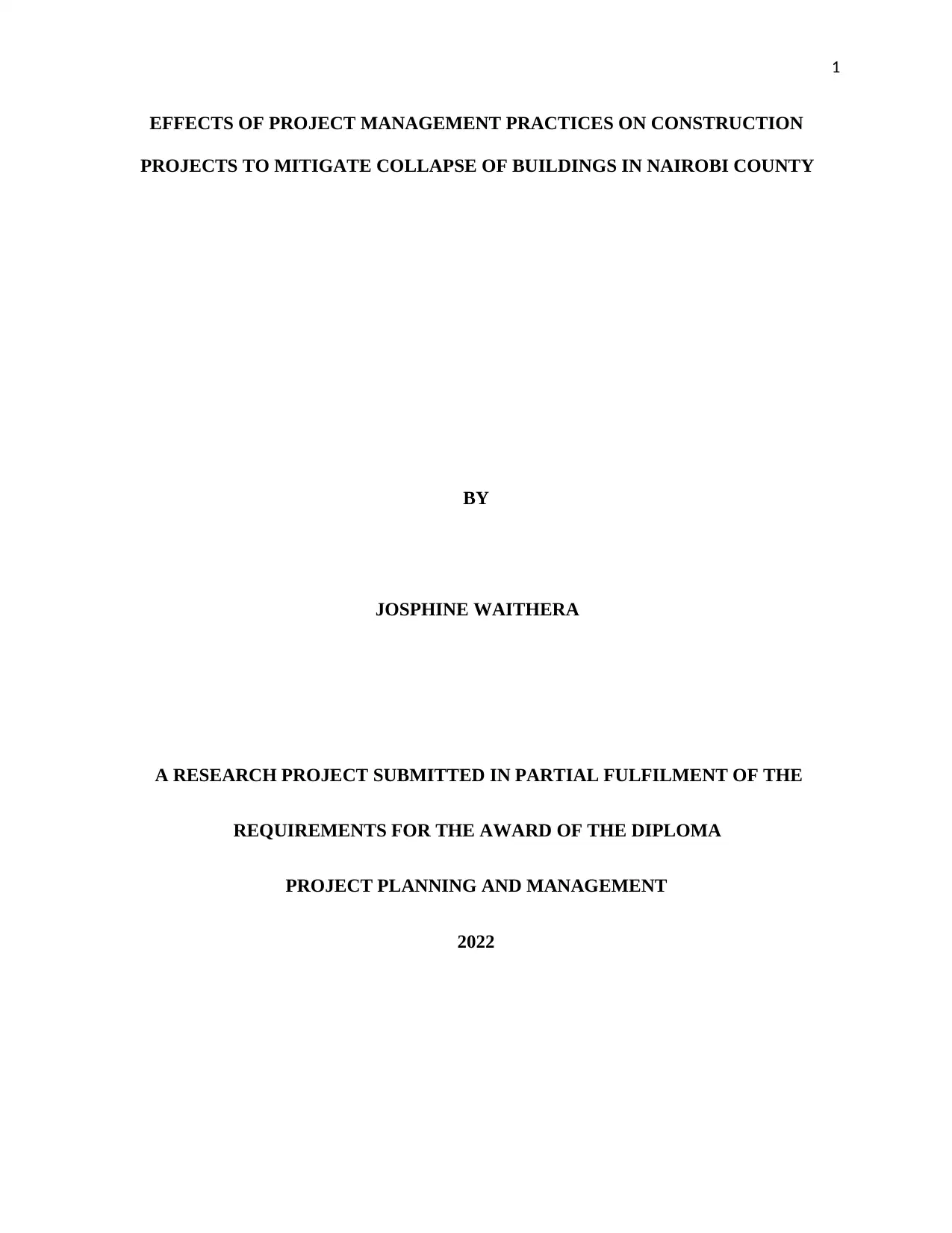
1
EFFECTS OF PROJECT MANAGEMENT PRACTICES ON CONSTRUCTION
PROJECTS TO MITIGATE COLLAPSE OF BUILDINGS IN NAIROBI COUNTY
BY
JOSPHINE WAITHERA
A RESEARCH PROJECT SUBMITTED IN PARTIAL FULFILMENT OF THE
REQUIREMENTS FOR THE AWARD OF THE DIPLOMA
PROJECT PLANNING AND MANAGEMENT
2022
EFFECTS OF PROJECT MANAGEMENT PRACTICES ON CONSTRUCTION
PROJECTS TO MITIGATE COLLAPSE OF BUILDINGS IN NAIROBI COUNTY
BY
JOSPHINE WAITHERA
A RESEARCH PROJECT SUBMITTED IN PARTIAL FULFILMENT OF THE
REQUIREMENTS FOR THE AWARD OF THE DIPLOMA
PROJECT PLANNING AND MANAGEMENT
2022
Secure Best Marks with AI Grader
Need help grading? Try our AI Grader for instant feedback on your assignments.
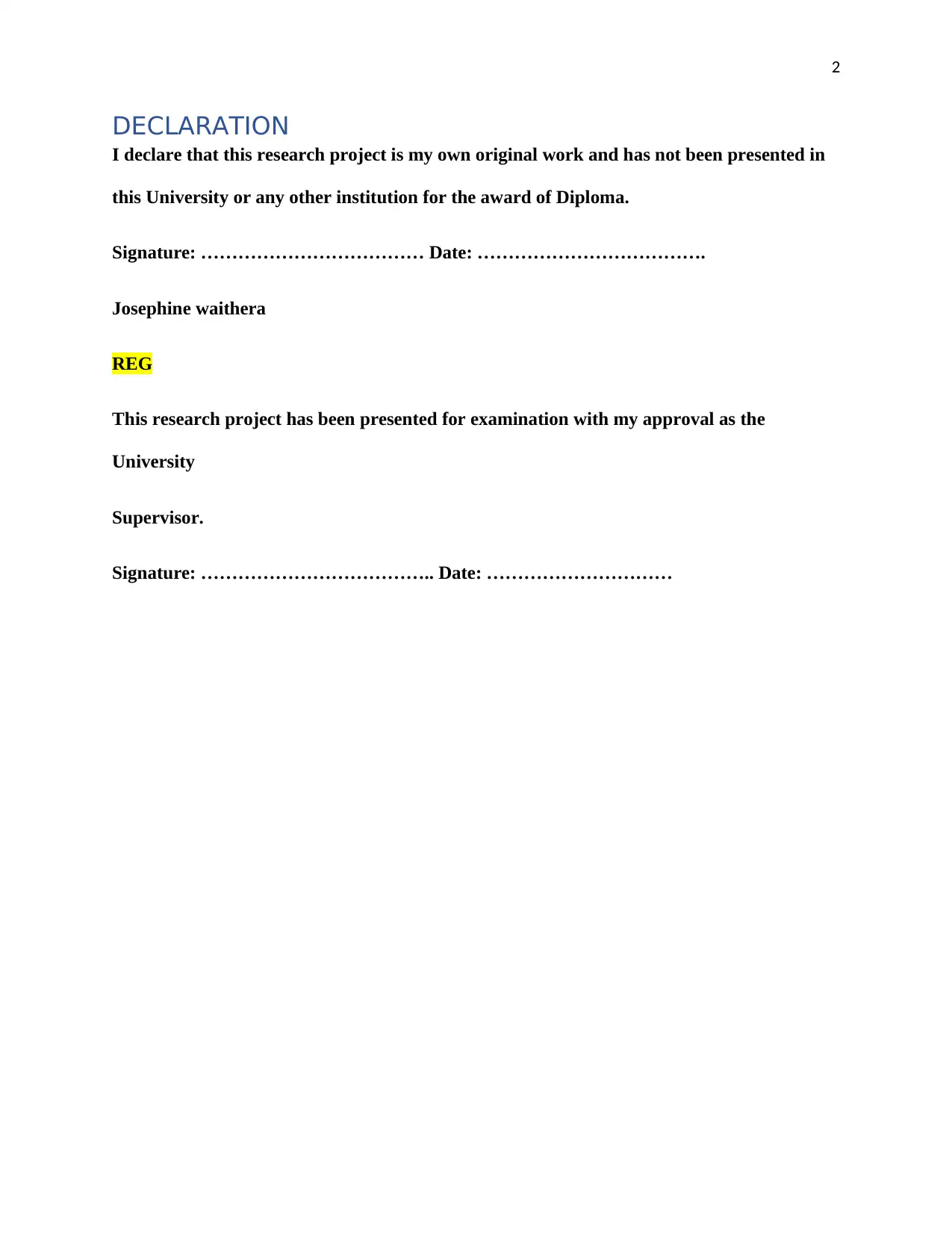
2
DECLARATION
I declare that this research project is my own original work and has not been presented in
this University or any other institution for the award of Diploma.
Signature: ……………………………… Date: ……………………………….
Josephine waithera
REG
This research project has been presented for examination with my approval as the
University
Supervisor.
Signature: ……………………………….. Date: …………………………
DECLARATION
I declare that this research project is my own original work and has not been presented in
this University or any other institution for the award of Diploma.
Signature: ……………………………… Date: ……………………………….
Josephine waithera
REG
This research project has been presented for examination with my approval as the
University
Supervisor.
Signature: ……………………………….. Date: …………………………

3
DEDICATION
I dedicate this research project to my family for their continued support during the period of
study
DEDICATION
I dedicate this research project to my family for their continued support during the period of
study

4
ACKNOWLEDGEMENT
From the inception of my study idea through the completion of this research project, I would like
to express my gratitude to Mr, who served as my supervisor. I am indebted to him for his
encouragement, supervision, and direction. Without his encouragement and insightful feedback, I
would not have been able to accomplish as much as I have.
In addition, I would like to recognize the efforts of all of the lecturers at the for the assistance
and training that I have received, both of which have had an effect on the information that I
possess.
I would want to express my gratitude to my coworkers for their encouragement and for making it
possible for me to devote the necessary amount of time to finishing this research project. I pray
that the All-Powerful God would shower each and every one of you with his plentiful blessings.
ACKNOWLEDGEMENT
From the inception of my study idea through the completion of this research project, I would like
to express my gratitude to Mr, who served as my supervisor. I am indebted to him for his
encouragement, supervision, and direction. Without his encouragement and insightful feedback, I
would not have been able to accomplish as much as I have.
In addition, I would like to recognize the efforts of all of the lecturers at the for the assistance
and training that I have received, both of which have had an effect on the information that I
possess.
I would want to express my gratitude to my coworkers for their encouragement and for making it
possible for me to devote the necessary amount of time to finishing this research project. I pray
that the All-Powerful God would shower each and every one of you with his plentiful blessings.
Paraphrase This Document
Need a fresh take? Get an instant paraphrase of this document with our AI Paraphraser
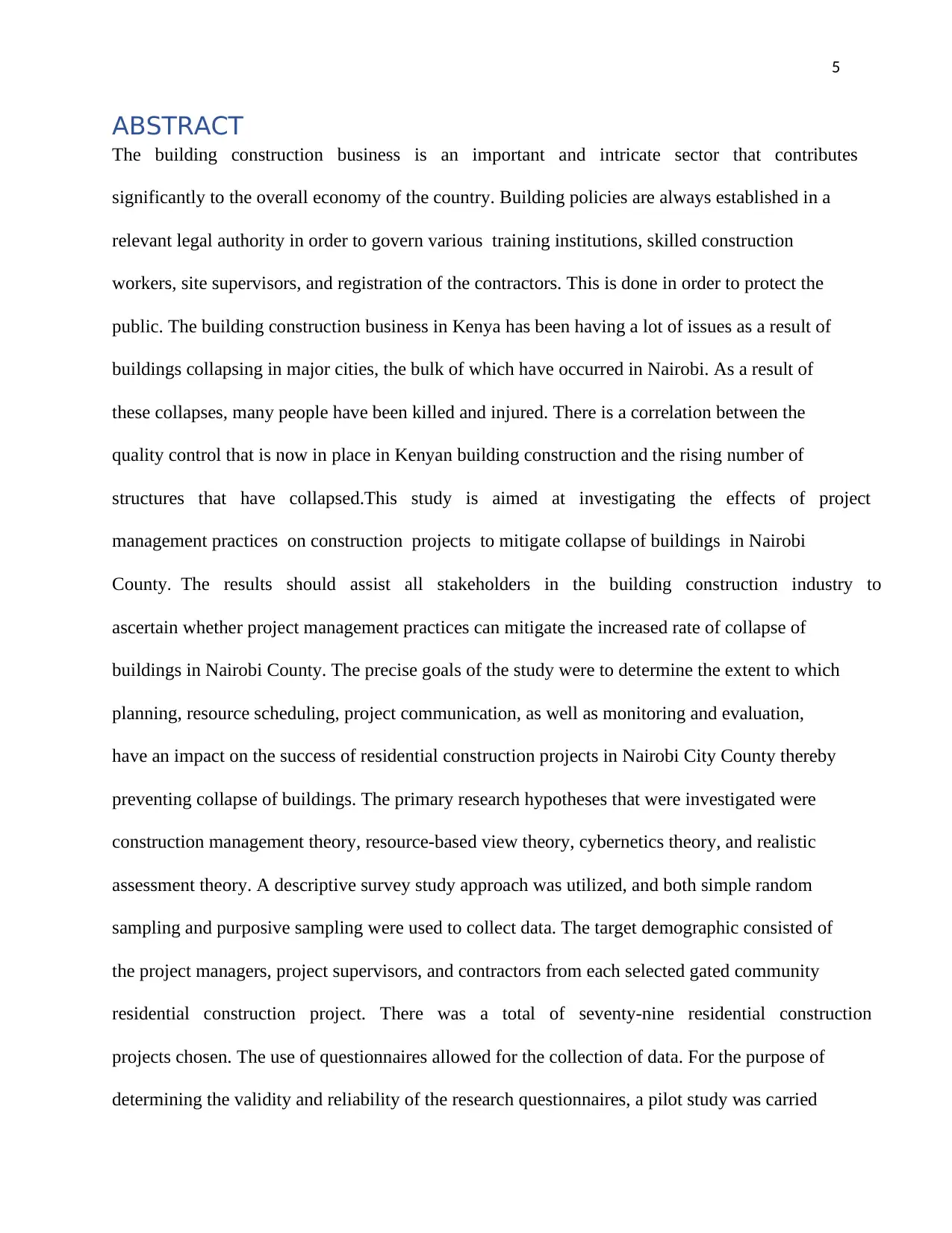
5
ABSTRACT
The building construction business is an important and intricate sector that contributes
significantly to the overall economy of the country. Building policies are always established in a
relevant legal authority in order to govern various training institutions, skilled construction
workers, site supervisors, and registration of the contractors. This is done in order to protect the
public. The building construction business in Kenya has been having a lot of issues as a result of
buildings collapsing in major cities, the bulk of which have occurred in Nairobi. As a result of
these collapses, many people have been killed and injured. There is a correlation between the
quality control that is now in place in Kenyan building construction and the rising number of
structures that have collapsed.This study is aimed at investigating the effects of project
management practices on construction projects to mitigate collapse of buildings in Nairobi
County. The results should assist all stakeholders in the building construction industry to
ascertain whether project management practices can mitigate the increased rate of collapse of
buildings in Nairobi County. The precise goals of the study were to determine the extent to which
planning, resource scheduling, project communication, as well as monitoring and evaluation,
have an impact on the success of residential construction projects in Nairobi City County thereby
preventing collapse of buildings. The primary research hypotheses that were investigated were
construction management theory, resource-based view theory, cybernetics theory, and realistic
assessment theory. A descriptive survey study approach was utilized, and both simple random
sampling and purposive sampling were used to collect data. The target demographic consisted of
the project managers, project supervisors, and contractors from each selected gated community
residential construction project. There was a total of seventy-nine residential construction
projects chosen. The use of questionnaires allowed for the collection of data. For the purpose of
determining the validity and reliability of the research questionnaires, a pilot study was carried
ABSTRACT
The building construction business is an important and intricate sector that contributes
significantly to the overall economy of the country. Building policies are always established in a
relevant legal authority in order to govern various training institutions, skilled construction
workers, site supervisors, and registration of the contractors. This is done in order to protect the
public. The building construction business in Kenya has been having a lot of issues as a result of
buildings collapsing in major cities, the bulk of which have occurred in Nairobi. As a result of
these collapses, many people have been killed and injured. There is a correlation between the
quality control that is now in place in Kenyan building construction and the rising number of
structures that have collapsed.This study is aimed at investigating the effects of project
management practices on construction projects to mitigate collapse of buildings in Nairobi
County. The results should assist all stakeholders in the building construction industry to
ascertain whether project management practices can mitigate the increased rate of collapse of
buildings in Nairobi County. The precise goals of the study were to determine the extent to which
planning, resource scheduling, project communication, as well as monitoring and evaluation,
have an impact on the success of residential construction projects in Nairobi City County thereby
preventing collapse of buildings. The primary research hypotheses that were investigated were
construction management theory, resource-based view theory, cybernetics theory, and realistic
assessment theory. A descriptive survey study approach was utilized, and both simple random
sampling and purposive sampling were used to collect data. The target demographic consisted of
the project managers, project supervisors, and contractors from each selected gated community
residential construction project. There was a total of seventy-nine residential construction
projects chosen. The use of questionnaires allowed for the collection of data. For the purpose of
determining the validity and reliability of the research questionnaires, a pilot study was carried

6
out. The content validity of the instrument was evaluated by both peer review and research expert
verification. Descriptive and inferential statistics were employed to undertake an analysis of the
data presented in tables. Project managers, project supervisors, contractors, and clients of
residential construction projects in gated communities will find the findings useful. According to
the study's findings, there is a strong correlation between project performance and planning,
resource scheduling, project communication, and project monitoring and assessment. According
to the conclusions of the study, successful project completion requires proper planning,
communication within the project, distribution of resources, and monitoring and evaluation.
According to the conclusions of the study, project managers, supervisors, and contractors should
consider fundamental project management strategies in order to improve the overall performance
of projects and prevent the increased collapse of buildings in Nairobi County.
out. The content validity of the instrument was evaluated by both peer review and research expert
verification. Descriptive and inferential statistics were employed to undertake an analysis of the
data presented in tables. Project managers, project supervisors, contractors, and clients of
residential construction projects in gated communities will find the findings useful. According to
the study's findings, there is a strong correlation between project performance and planning,
resource scheduling, project communication, and project monitoring and assessment. According
to the conclusions of the study, successful project completion requires proper planning,
communication within the project, distribution of resources, and monitoring and evaluation.
According to the conclusions of the study, project managers, supervisors, and contractors should
consider fundamental project management strategies in order to improve the overall performance
of projects and prevent the increased collapse of buildings in Nairobi County.
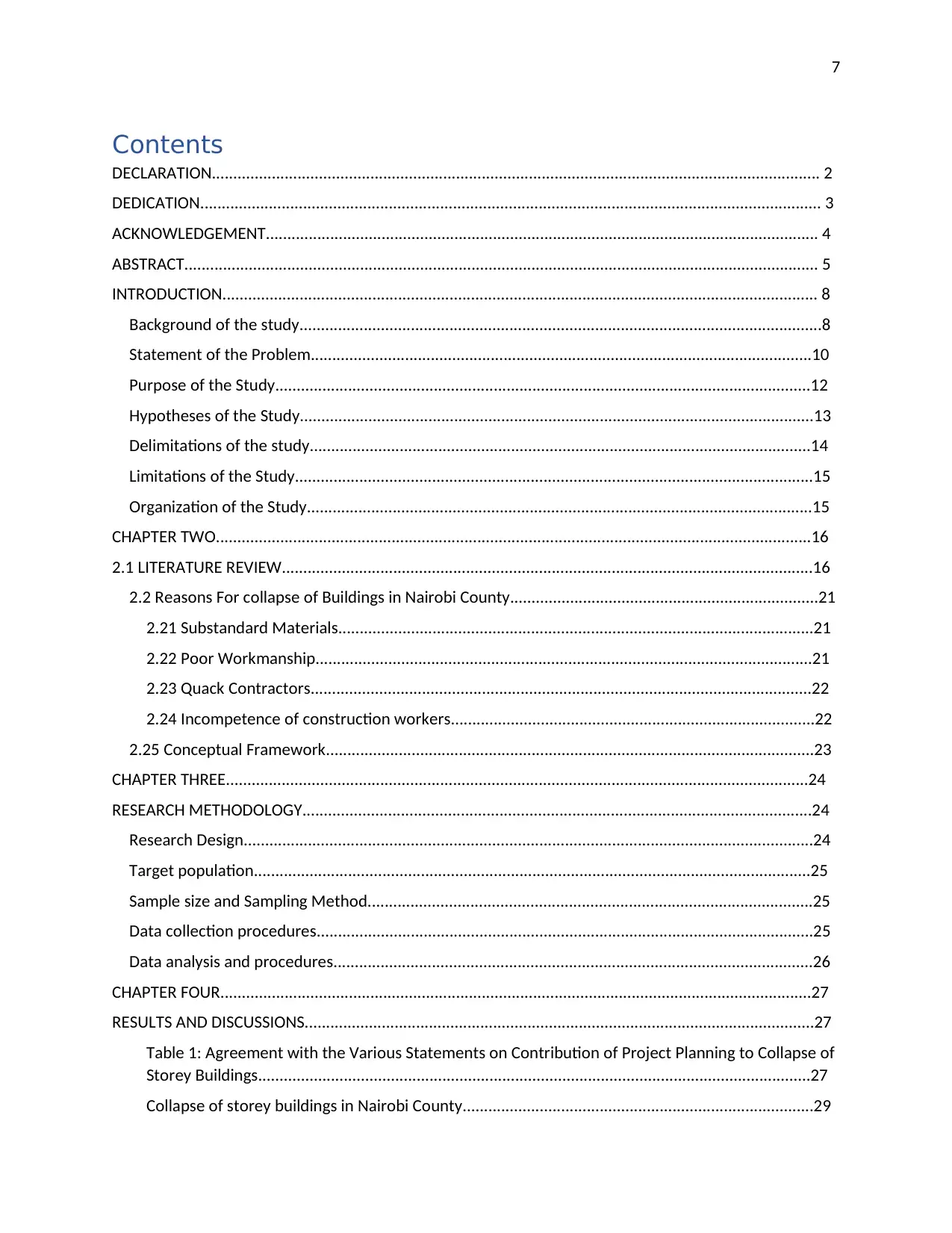
7
Contents
DECLARATION.............................................................................................................................................. 2
DEDICATION................................................................................................................................................. 3
ACKNOWLEDGEMENT................................................................................................................................. 4
ABSTRACT.................................................................................................................................................... 5
INTRODUCTION........................................................................................................................................... 8
Background of the study..........................................................................................................................8
Statement of the Problem.....................................................................................................................10
Purpose of the Study.............................................................................................................................12
Hypotheses of the Study........................................................................................................................13
Delimitations of the study.....................................................................................................................14
Limitations of the Study.........................................................................................................................15
Organization of the Study......................................................................................................................15
CHAPTER TWO...........................................................................................................................................16
2.1 LITERATURE REVIEW............................................................................................................................16
2.2 Reasons For collapse of Buildings in Nairobi County........................................................................21
2.21 Substandard Materials...............................................................................................................21
2.22 Poor Workmanship....................................................................................................................21
2.23 Quack Contractors.....................................................................................................................22
2.24 Incompetence of construction workers.....................................................................................22
2.25 Conceptual Framework..................................................................................................................23
CHAPTER THREE........................................................................................................................................24
RESEARCH METHODOLOGY.......................................................................................................................24
Research Design.....................................................................................................................................24
Target population..................................................................................................................................25
Sample size and Sampling Method........................................................................................................25
Data collection procedures....................................................................................................................25
Data analysis and procedures................................................................................................................26
CHAPTER FOUR..........................................................................................................................................27
RESULTS AND DISCUSSIONS.......................................................................................................................27
Table 1: Agreement with the Various Statements on Contribution of Project Planning to Collapse of
Storey Buildings.................................................................................................................................27
Collapse of storey buildings in Nairobi County..................................................................................29
Contents
DECLARATION.............................................................................................................................................. 2
DEDICATION................................................................................................................................................. 3
ACKNOWLEDGEMENT................................................................................................................................. 4
ABSTRACT.................................................................................................................................................... 5
INTRODUCTION........................................................................................................................................... 8
Background of the study..........................................................................................................................8
Statement of the Problem.....................................................................................................................10
Purpose of the Study.............................................................................................................................12
Hypotheses of the Study........................................................................................................................13
Delimitations of the study.....................................................................................................................14
Limitations of the Study.........................................................................................................................15
Organization of the Study......................................................................................................................15
CHAPTER TWO...........................................................................................................................................16
2.1 LITERATURE REVIEW............................................................................................................................16
2.2 Reasons For collapse of Buildings in Nairobi County........................................................................21
2.21 Substandard Materials...............................................................................................................21
2.22 Poor Workmanship....................................................................................................................21
2.23 Quack Contractors.....................................................................................................................22
2.24 Incompetence of construction workers.....................................................................................22
2.25 Conceptual Framework..................................................................................................................23
CHAPTER THREE........................................................................................................................................24
RESEARCH METHODOLOGY.......................................................................................................................24
Research Design.....................................................................................................................................24
Target population..................................................................................................................................25
Sample size and Sampling Method........................................................................................................25
Data collection procedures....................................................................................................................25
Data analysis and procedures................................................................................................................26
CHAPTER FOUR..........................................................................................................................................27
RESULTS AND DISCUSSIONS.......................................................................................................................27
Table 1: Agreement with the Various Statements on Contribution of Project Planning to Collapse of
Storey Buildings.................................................................................................................................27
Collapse of storey buildings in Nairobi County..................................................................................29
Secure Best Marks with AI Grader
Need help grading? Try our AI Grader for instant feedback on your assignments.
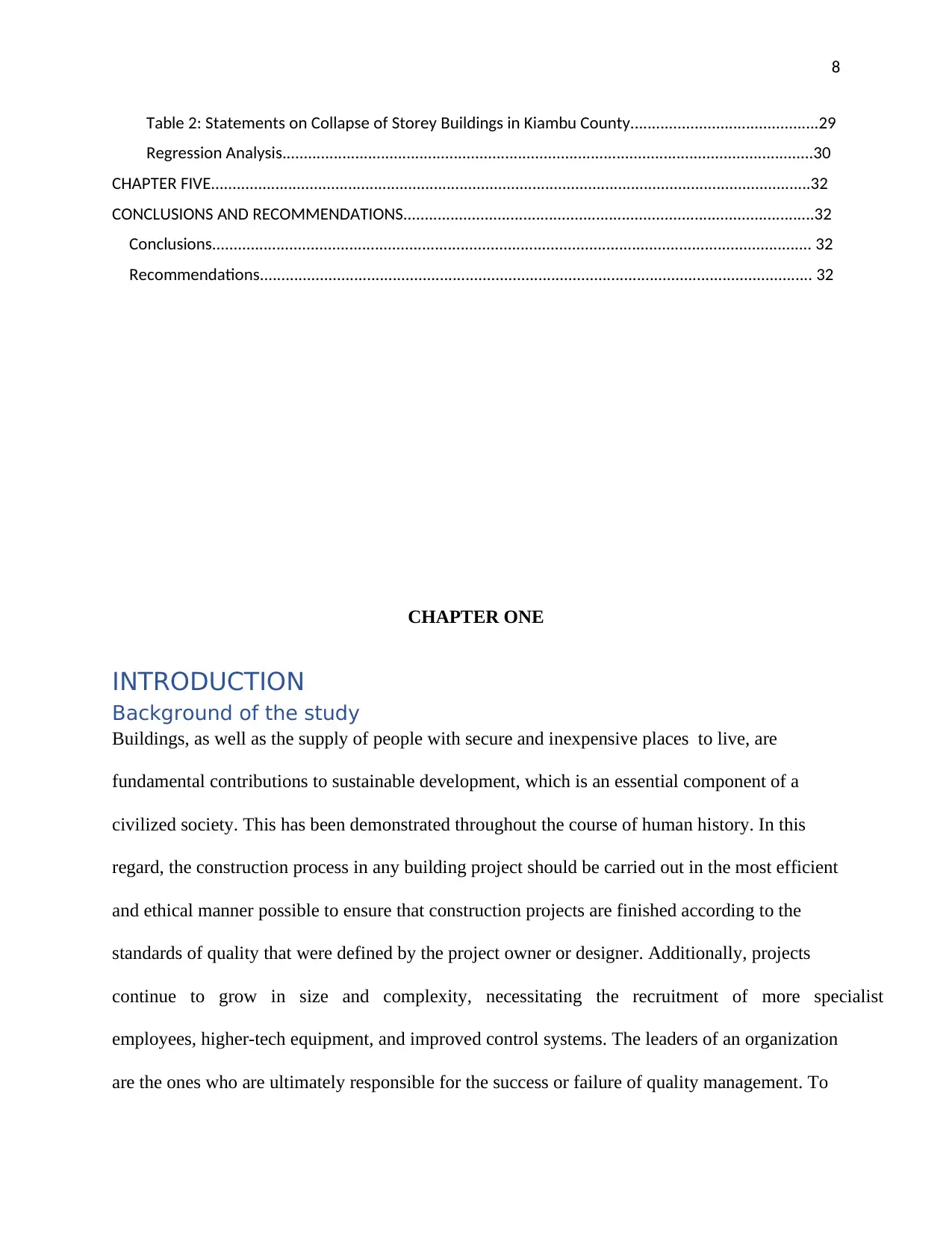
8
Table 2: Statements on Collapse of Storey Buildings in Kiambu County............................................29
Regression Analysis............................................................................................................................30
CHAPTER FIVE............................................................................................................................................32
CONCLUSIONS AND RECOMMENDATIONS................................................................................................32
Conclusions............................................................................................................................................ 32
Recommendations................................................................................................................................. 32
CHAPTER ONE
INTRODUCTION
Background of the study
Buildings, as well as the supply of people with secure and inexpensive places to live, are
fundamental contributions to sustainable development, which is an essential component of a
civilized society. This has been demonstrated throughout the course of human history. In this
regard, the construction process in any building project should be carried out in the most efficient
and ethical manner possible to ensure that construction projects are finished according to the
standards of quality that were defined by the project owner or designer. Additionally, projects
continue to grow in size and complexity, necessitating the recruitment of more specialist
employees, higher-tech equipment, and improved control systems. The leaders of an organization
are the ones who are ultimately responsible for the success or failure of quality management. To
Table 2: Statements on Collapse of Storey Buildings in Kiambu County............................................29
Regression Analysis............................................................................................................................30
CHAPTER FIVE............................................................................................................................................32
CONCLUSIONS AND RECOMMENDATIONS................................................................................................32
Conclusions............................................................................................................................................ 32
Recommendations................................................................................................................................. 32
CHAPTER ONE
INTRODUCTION
Background of the study
Buildings, as well as the supply of people with secure and inexpensive places to live, are
fundamental contributions to sustainable development, which is an essential component of a
civilized society. This has been demonstrated throughout the course of human history. In this
regard, the construction process in any building project should be carried out in the most efficient
and ethical manner possible to ensure that construction projects are finished according to the
standards of quality that were defined by the project owner or designer. Additionally, projects
continue to grow in size and complexity, necessitating the recruitment of more specialist
employees, higher-tech equipment, and improved control systems. The leaders of an organization
are the ones who are ultimately responsible for the success or failure of quality management. To

9
be able to successfully complete their construction projects, future project leaders will need to
possess both ethical and leadership skills. Failure of a project is typically the result when such
talents are missing or are insufficient. It is imperative that concerted efforts be made to guarantee
that quality is not sacrificed and that those who will benefit from the project receive the very best
in terms of a dependable, comprehensive, and environmentally friendly endeavor. The level of
quality ought to be the primary concern.
The ever-increasing population of city dwellers in Nairobi, the capital city, has witnessed the
mushrooming of residential constructions all throughout the city. As a result of the poor quality
of many of these constructions, building collapses have become all too common in Nairobi in
recent times, resulting in both fatalities and injuries. Since 2006, multiple instances of buildings
collapse have been reported in the city of Nairobi on a variety of dates. These incidents have
resulted in a number of people losing their lives as well as dozens more being hurt, crippled, or
permanently deformed.
According to a report that was given by the National Building Inspectorate in 2015, audits were
conducted in 2015 to determine the status of buildings in Nairobi. The National Building
Inspectorate is responsible for auditing buildings to ensure that they conform to land registration,
planning, zoning, building standards, and structural soundness. An inspection of 2,601 buildings
in Nairobi was carried out by the NBI, in collaboration with the County Government and the
NCA, and was finished in May of 2015. As a result of this activity, fifty-five problematic
buildings in the Huruma/Kiamaiko area were found. Following this, in December of 2015, it
proceeded to identify additional defective buildings in the areas of Umoja (28), Dagoretti (16),
Zimmerman (29), Thome Estate and Marurui (9), Githurai 44 (16), Garden Estate, Mirema (1),
be able to successfully complete their construction projects, future project leaders will need to
possess both ethical and leadership skills. Failure of a project is typically the result when such
talents are missing or are insufficient. It is imperative that concerted efforts be made to guarantee
that quality is not sacrificed and that those who will benefit from the project receive the very best
in terms of a dependable, comprehensive, and environmentally friendly endeavor. The level of
quality ought to be the primary concern.
The ever-increasing population of city dwellers in Nairobi, the capital city, has witnessed the
mushrooming of residential constructions all throughout the city. As a result of the poor quality
of many of these constructions, building collapses have become all too common in Nairobi in
recent times, resulting in both fatalities and injuries. Since 2006, multiple instances of buildings
collapse have been reported in the city of Nairobi on a variety of dates. These incidents have
resulted in a number of people losing their lives as well as dozens more being hurt, crippled, or
permanently deformed.
According to a report that was given by the National Building Inspectorate in 2015, audits were
conducted in 2015 to determine the status of buildings in Nairobi. The National Building
Inspectorate is responsible for auditing buildings to ensure that they conform to land registration,
planning, zoning, building standards, and structural soundness. An inspection of 2,601 buildings
in Nairobi was carried out by the NBI, in collaboration with the County Government and the
NCA, and was finished in May of 2015. As a result of this activity, fifty-five problematic
buildings in the Huruma/Kiamaiko area were found. Following this, in December of 2015, it
proceeded to identify additional defective buildings in the areas of Umoja (28), Dagoretti (16),
Zimmerman (29), Thome Estate and Marurui (9), Githurai 44 (16), Garden Estate, Mirema (1),
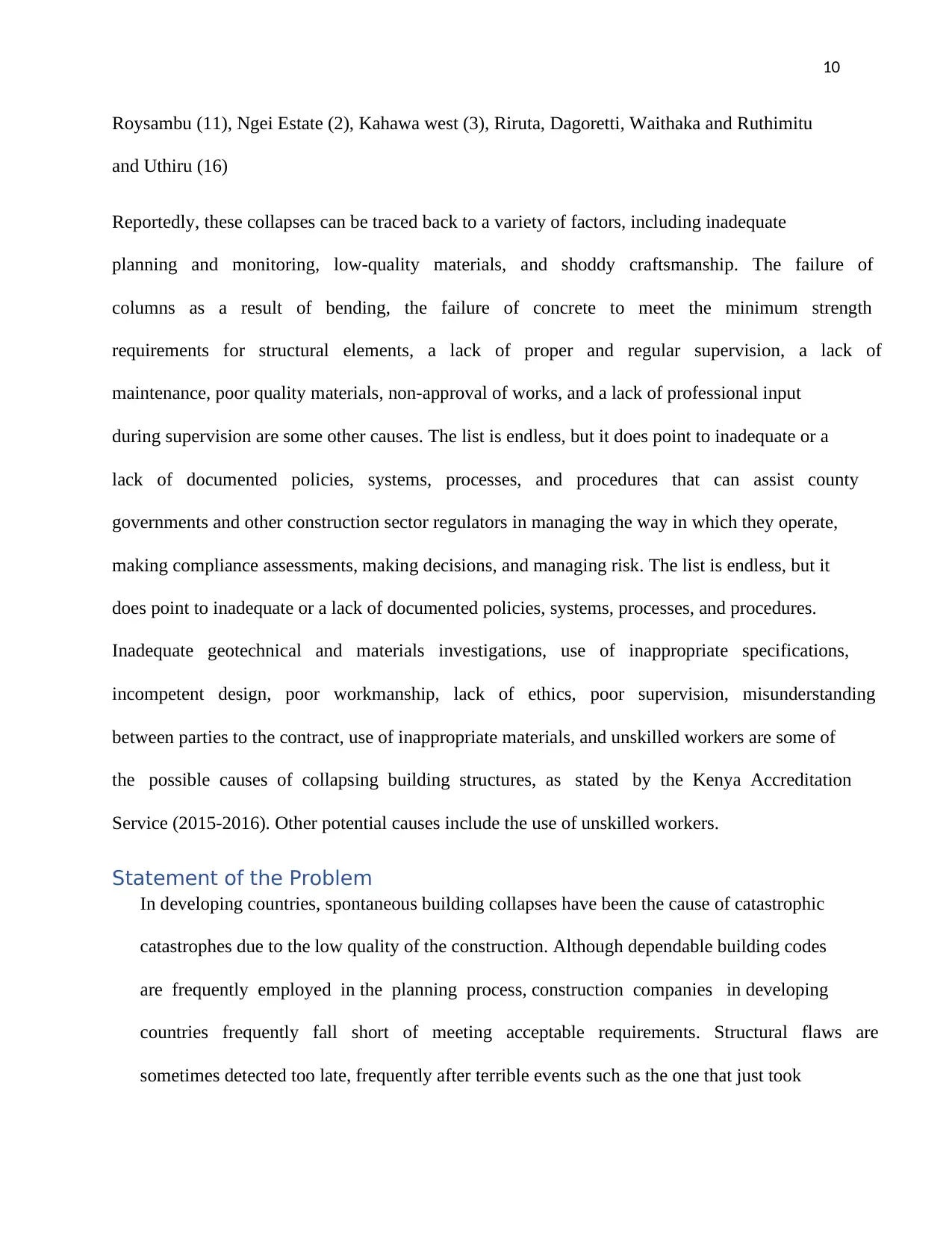
10
Roysambu (11), Ngei Estate (2), Kahawa west (3), Riruta, Dagoretti, Waithaka and Ruthimitu
and Uthiru (16)
Reportedly, these collapses can be traced back to a variety of factors, including inadequate
planning and monitoring, low-quality materials, and shoddy craftsmanship. The failure of
columns as a result of bending, the failure of concrete to meet the minimum strength
requirements for structural elements, a lack of proper and regular supervision, a lack of
maintenance, poor quality materials, non-approval of works, and a lack of professional input
during supervision are some other causes. The list is endless, but it does point to inadequate or a
lack of documented policies, systems, processes, and procedures that can assist county
governments and other construction sector regulators in managing the way in which they operate,
making compliance assessments, making decisions, and managing risk. The list is endless, but it
does point to inadequate or a lack of documented policies, systems, processes, and procedures.
Inadequate geotechnical and materials investigations, use of inappropriate specifications,
incompetent design, poor workmanship, lack of ethics, poor supervision, misunderstanding
between parties to the contract, use of inappropriate materials, and unskilled workers are some of
the possible causes of collapsing building structures, as stated by the Kenya Accreditation
Service (2015-2016). Other potential causes include the use of unskilled workers.
Statement of the Problem
In developing countries, spontaneous building collapses have been the cause of catastrophic
catastrophes due to the low quality of the construction. Although dependable building codes
are frequently employed in the planning process, construction companies in developing
countries frequently fall short of meeting acceptable requirements. Structural flaws are
sometimes detected too late, frequently after terrible events such as the one that just took
Roysambu (11), Ngei Estate (2), Kahawa west (3), Riruta, Dagoretti, Waithaka and Ruthimitu
and Uthiru (16)
Reportedly, these collapses can be traced back to a variety of factors, including inadequate
planning and monitoring, low-quality materials, and shoddy craftsmanship. The failure of
columns as a result of bending, the failure of concrete to meet the minimum strength
requirements for structural elements, a lack of proper and regular supervision, a lack of
maintenance, poor quality materials, non-approval of works, and a lack of professional input
during supervision are some other causes. The list is endless, but it does point to inadequate or a
lack of documented policies, systems, processes, and procedures that can assist county
governments and other construction sector regulators in managing the way in which they operate,
making compliance assessments, making decisions, and managing risk. The list is endless, but it
does point to inadequate or a lack of documented policies, systems, processes, and procedures.
Inadequate geotechnical and materials investigations, use of inappropriate specifications,
incompetent design, poor workmanship, lack of ethics, poor supervision, misunderstanding
between parties to the contract, use of inappropriate materials, and unskilled workers are some of
the possible causes of collapsing building structures, as stated by the Kenya Accreditation
Service (2015-2016). Other potential causes include the use of unskilled workers.
Statement of the Problem
In developing countries, spontaneous building collapses have been the cause of catastrophic
catastrophes due to the low quality of the construction. Although dependable building codes
are frequently employed in the planning process, construction companies in developing
countries frequently fall short of meeting acceptable requirements. Structural flaws are
sometimes detected too late, frequently after terrible events such as the one that just took
Paraphrase This Document
Need a fresh take? Get an instant paraphrase of this document with our AI Paraphraser

11
place in Kenya, show that this problem is not specific to any one country or region. The
expansion of the construction industry in Kenya has led to the establishment of a number of
unethical business practices in the country. behaviors that go against established standards of
conduct. when financial aspects of construction procedures are not handled in a competent
and timely manner. If the process is not carried out in an ethical manner, then the parties
participating in it may be able to engage in unethical and unprofessional behavior, which is
detrimental to their career and, most significantly, reduces the overall quality of the project.
In recent years, Kenya has seen an increase in the number of newly constructed residential
buildings. There has been a reduction in quality across all dimensions. It is widely believed,
despite the fact that the government of Kenya established the National Building Inspectorate,
that the building construction business is very prone to ethical difficulties, which ultimately
results in the collapse of buildings with disastrous consequences.
The political, the economic, and the social are the three pillars that support Vision 2030. A
social pillar with the goal of bettering the overall standard of living for all Kenyans. As part
of the social pillar, the government's objective is to appropriately and decently house the
country's population in an environment that is environmentally sustainable. Housing and
urbanization One of the ways in which this can be accomplished is by ensuring the
construction of reasonably priced housing of a high standard. This can be accomplished by
employing appropriate project management techniques during the building construction
process and implementing quality control procedures at each stage. it has been proven that
there is an issue with inadequate quality being achieved in the construction of buildings all
over the world. warned of the danger of building collapse in Kenya due to the construction of
thousands of buildings that were dangerously weak, and recommended that unless better
place in Kenya, show that this problem is not specific to any one country or region. The
expansion of the construction industry in Kenya has led to the establishment of a number of
unethical business practices in the country. behaviors that go against established standards of
conduct. when financial aspects of construction procedures are not handled in a competent
and timely manner. If the process is not carried out in an ethical manner, then the parties
participating in it may be able to engage in unethical and unprofessional behavior, which is
detrimental to their career and, most significantly, reduces the overall quality of the project.
In recent years, Kenya has seen an increase in the number of newly constructed residential
buildings. There has been a reduction in quality across all dimensions. It is widely believed,
despite the fact that the government of Kenya established the National Building Inspectorate,
that the building construction business is very prone to ethical difficulties, which ultimately
results in the collapse of buildings with disastrous consequences.
The political, the economic, and the social are the three pillars that support Vision 2030. A
social pillar with the goal of bettering the overall standard of living for all Kenyans. As part
of the social pillar, the government's objective is to appropriately and decently house the
country's population in an environment that is environmentally sustainable. Housing and
urbanization One of the ways in which this can be accomplished is by ensuring the
construction of reasonably priced housing of a high standard. This can be accomplished by
employing appropriate project management techniques during the building construction
process and implementing quality control procedures at each stage. it has been proven that
there is an issue with inadequate quality being achieved in the construction of buildings all
over the world. warned of the danger of building collapse in Kenya due to the construction of
thousands of buildings that were dangerously weak, and recommended that unless better
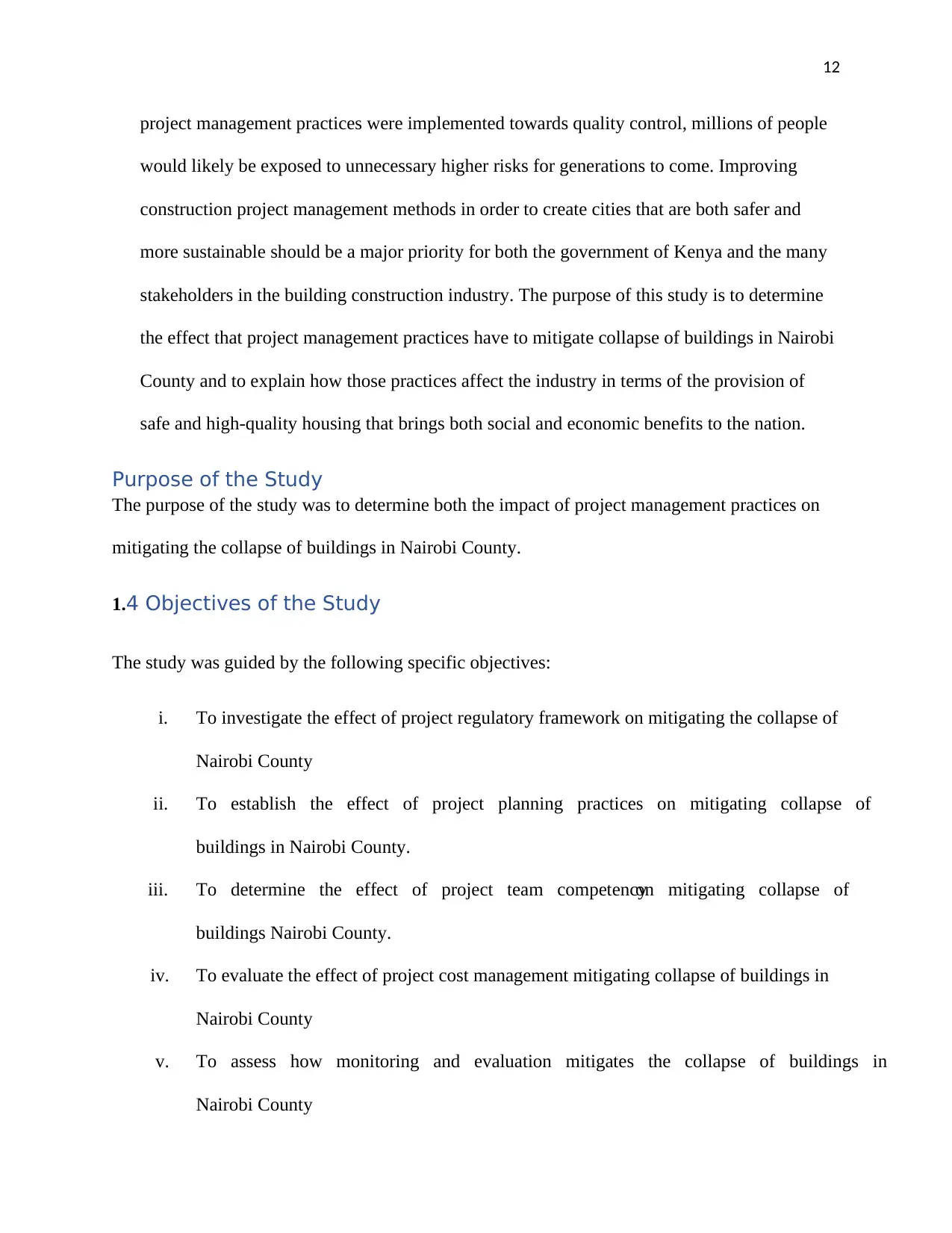
12
project management practices were implemented towards quality control, millions of people
would likely be exposed to unnecessary higher risks for generations to come. Improving
construction project management methods in order to create cities that are both safer and
more sustainable should be a major priority for both the government of Kenya and the many
stakeholders in the building construction industry. The purpose of this study is to determine
the effect that project management practices have to mitigate collapse of buildings in Nairobi
County and to explain how those practices affect the industry in terms of the provision of
safe and high-quality housing that brings both social and economic benefits to the nation.
Purpose of the Study
The purpose of the study was to determine both the impact of project management practices on
mitigating the collapse of buildings in Nairobi County.
1.4 Objectives of the Study
The study was guided by the following specific objectives:
i. To investigate the effect of project regulatory framework on mitigating the collapse of
Nairobi County
ii. To establish the effect of project planning practices on mitigating collapse of
buildings in Nairobi County.
iii. To determine the effect of project team competencyon mitigating collapse of
buildings Nairobi County.
iv. To evaluate the effect of project cost management mitigating collapse of buildings in
Nairobi County
v. To assess how monitoring and evaluation mitigates the collapse of buildings in
Nairobi County
project management practices were implemented towards quality control, millions of people
would likely be exposed to unnecessary higher risks for generations to come. Improving
construction project management methods in order to create cities that are both safer and
more sustainable should be a major priority for both the government of Kenya and the many
stakeholders in the building construction industry. The purpose of this study is to determine
the effect that project management practices have to mitigate collapse of buildings in Nairobi
County and to explain how those practices affect the industry in terms of the provision of
safe and high-quality housing that brings both social and economic benefits to the nation.
Purpose of the Study
The purpose of the study was to determine both the impact of project management practices on
mitigating the collapse of buildings in Nairobi County.
1.4 Objectives of the Study
The study was guided by the following specific objectives:
i. To investigate the effect of project regulatory framework on mitigating the collapse of
Nairobi County
ii. To establish the effect of project planning practices on mitigating collapse of
buildings in Nairobi County.
iii. To determine the effect of project team competencyon mitigating collapse of
buildings Nairobi County.
iv. To evaluate the effect of project cost management mitigating collapse of buildings in
Nairobi County
v. To assess how monitoring and evaluation mitigates the collapse of buildings in
Nairobi County
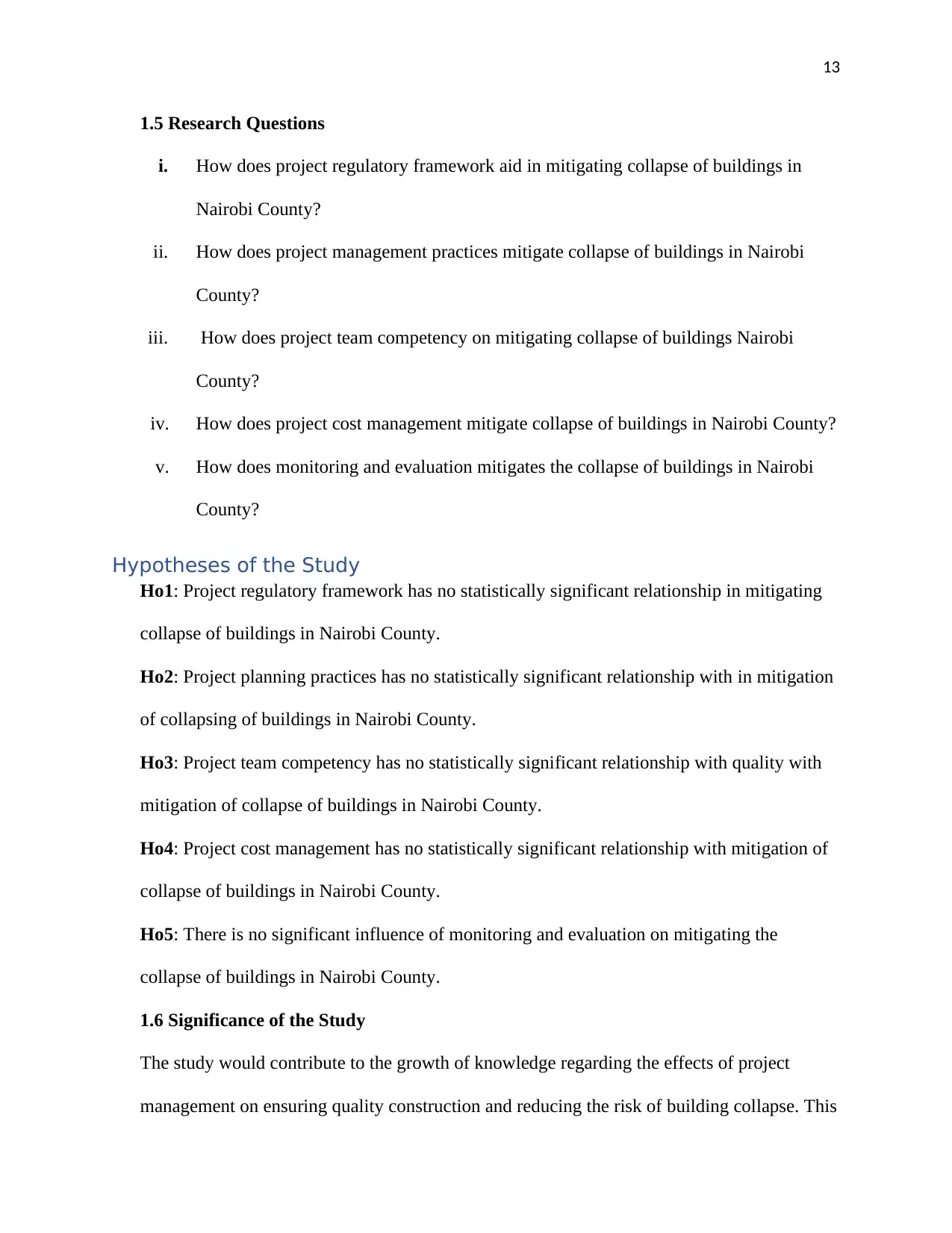
13
1.5 Research Questions
i. How does project regulatory framework aid in mitigating collapse of buildings in
Nairobi County?
ii. How does project management practices mitigate collapse of buildings in Nairobi
County?
iii. How does project team competency on mitigating collapse of buildings Nairobi
County?
iv. How does project cost management mitigate collapse of buildings in Nairobi County?
v. How does monitoring and evaluation mitigates the collapse of buildings in Nairobi
County?
Hypotheses of the Study
Ho1: Project regulatory framework has no statistically significant relationship in mitigating
collapse of buildings in Nairobi County.
Ho2: Project planning practices has no statistically significant relationship with in mitigation
of collapsing of buildings in Nairobi County.
Ho3: Project team competency has no statistically significant relationship with quality with
mitigation of collapse of buildings in Nairobi County.
Ho4: Project cost management has no statistically significant relationship with mitigation of
collapse of buildings in Nairobi County.
Ho5: There is no significant influence of monitoring and evaluation on mitigating the
collapse of buildings in Nairobi County.
1.6 Significance of the Study
The study would contribute to the growth of knowledge regarding the effects of project
management on ensuring quality construction and reducing the risk of building collapse. This
1.5 Research Questions
i. How does project regulatory framework aid in mitigating collapse of buildings in
Nairobi County?
ii. How does project management practices mitigate collapse of buildings in Nairobi
County?
iii. How does project team competency on mitigating collapse of buildings Nairobi
County?
iv. How does project cost management mitigate collapse of buildings in Nairobi County?
v. How does monitoring and evaluation mitigates the collapse of buildings in Nairobi
County?
Hypotheses of the Study
Ho1: Project regulatory framework has no statistically significant relationship in mitigating
collapse of buildings in Nairobi County.
Ho2: Project planning practices has no statistically significant relationship with in mitigation
of collapsing of buildings in Nairobi County.
Ho3: Project team competency has no statistically significant relationship with quality with
mitigation of collapse of buildings in Nairobi County.
Ho4: Project cost management has no statistically significant relationship with mitigation of
collapse of buildings in Nairobi County.
Ho5: There is no significant influence of monitoring and evaluation on mitigating the
collapse of buildings in Nairobi County.
1.6 Significance of the Study
The study would contribute to the growth of knowledge regarding the effects of project
management on ensuring quality construction and reducing the risk of building collapse. This
Secure Best Marks with AI Grader
Need help grading? Try our AI Grader for instant feedback on your assignments.

14
would serve as a longer-term deterrent for those considering building structures that do not
meet minimum requirements. Project organizations would be given the ability to work
toward applying project management skills in their projects and would be encouraged to
disassociate themselves from projects in which the ethics are in question in order to protect
their reputations in the long run. The study's findings would also be useful for developing a
framework for assessing the presence of project management skills systems in construction
industry organizations. The framework would be constructed based on the best practices that
were found through the literature study and the questionnaire survey. The framework would
provide construction organizations with a way for examining the presence of project
management skills in upholding ethical standards, identifying gaps, and implementing
strategies to close identified gaps. If construction companies implemented the framework, it
would assist in reducing the number of building collapses. Implementation of the framework
would also serve as a reference point for external institutions in order to establish
construction organizations' commitment to integrity and the construction of high-quality
residential buildings through the adoption of project management practices. This
commitment would be established through the framework's adoption.
1.7 Assumptions of the Study
The first assumption is that the variables of the study would not be subject to change during
the research period as this would affect the validity of the results; the second assumption is
that the sample that was chosen was adequate to help in drawing valid conclusions; and the
final assumption is that the respondents would be honest in giving the required information.
Delimitations of the study
The study's primary focus was on the impact of project management practices on the quality
of construction and the prevention of building collapse in Nairobi County. The unit of
would serve as a longer-term deterrent for those considering building structures that do not
meet minimum requirements. Project organizations would be given the ability to work
toward applying project management skills in their projects and would be encouraged to
disassociate themselves from projects in which the ethics are in question in order to protect
their reputations in the long run. The study's findings would also be useful for developing a
framework for assessing the presence of project management skills systems in construction
industry organizations. The framework would be constructed based on the best practices that
were found through the literature study and the questionnaire survey. The framework would
provide construction organizations with a way for examining the presence of project
management skills in upholding ethical standards, identifying gaps, and implementing
strategies to close identified gaps. If construction companies implemented the framework, it
would assist in reducing the number of building collapses. Implementation of the framework
would also serve as a reference point for external institutions in order to establish
construction organizations' commitment to integrity and the construction of high-quality
residential buildings through the adoption of project management practices. This
commitment would be established through the framework's adoption.
1.7 Assumptions of the Study
The first assumption is that the variables of the study would not be subject to change during
the research period as this would affect the validity of the results; the second assumption is
that the sample that was chosen was adequate to help in drawing valid conclusions; and the
final assumption is that the respondents would be honest in giving the required information.
Delimitations of the study
The study's primary focus was on the impact of project management practices on the quality
of construction and the prevention of building collapse in Nairobi County. The unit of
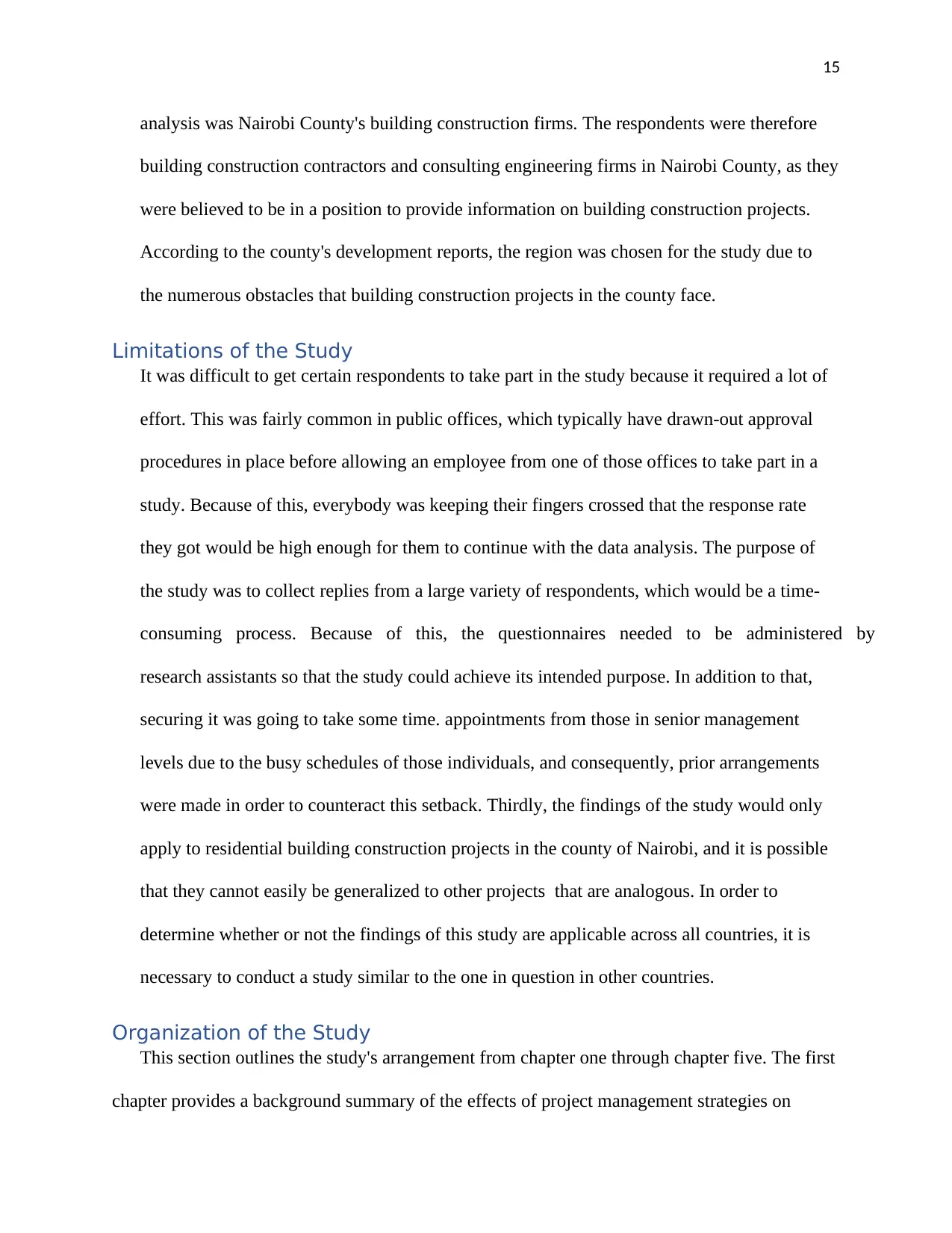
15
analysis was Nairobi County's building construction firms. The respondents were therefore
building construction contractors and consulting engineering firms in Nairobi County, as they
were believed to be in a position to provide information on building construction projects.
According to the county's development reports, the region was chosen for the study due to
the numerous obstacles that building construction projects in the county face.
Limitations of the Study
It was difficult to get certain respondents to take part in the study because it required a lot of
effort. This was fairly common in public offices, which typically have drawn-out approval
procedures in place before allowing an employee from one of those offices to take part in a
study. Because of this, everybody was keeping their fingers crossed that the response rate
they got would be high enough for them to continue with the data analysis. The purpose of
the study was to collect replies from a large variety of respondents, which would be a time-
consuming process. Because of this, the questionnaires needed to be administered by
research assistants so that the study could achieve its intended purpose. In addition to that,
securing it was going to take some time. appointments from those in senior management
levels due to the busy schedules of those individuals, and consequently, prior arrangements
were made in order to counteract this setback. Thirdly, the findings of the study would only
apply to residential building construction projects in the county of Nairobi, and it is possible
that they cannot easily be generalized to other projects that are analogous. In order to
determine whether or not the findings of this study are applicable across all countries, it is
necessary to conduct a study similar to the one in question in other countries.
Organization of the Study
This section outlines the study's arrangement from chapter one through chapter five. The first
chapter provides a background summary of the effects of project management strategies on
analysis was Nairobi County's building construction firms. The respondents were therefore
building construction contractors and consulting engineering firms in Nairobi County, as they
were believed to be in a position to provide information on building construction projects.
According to the county's development reports, the region was chosen for the study due to
the numerous obstacles that building construction projects in the county face.
Limitations of the Study
It was difficult to get certain respondents to take part in the study because it required a lot of
effort. This was fairly common in public offices, which typically have drawn-out approval
procedures in place before allowing an employee from one of those offices to take part in a
study. Because of this, everybody was keeping their fingers crossed that the response rate
they got would be high enough for them to continue with the data analysis. The purpose of
the study was to collect replies from a large variety of respondents, which would be a time-
consuming process. Because of this, the questionnaires needed to be administered by
research assistants so that the study could achieve its intended purpose. In addition to that,
securing it was going to take some time. appointments from those in senior management
levels due to the busy schedules of those individuals, and consequently, prior arrangements
were made in order to counteract this setback. Thirdly, the findings of the study would only
apply to residential building construction projects in the county of Nairobi, and it is possible
that they cannot easily be generalized to other projects that are analogous. In order to
determine whether or not the findings of this study are applicable across all countries, it is
necessary to conduct a study similar to the one in question in other countries.
Organization of the Study
This section outlines the study's arrangement from chapter one through chapter five. The first
chapter provides a background summary of the effects of project management strategies on
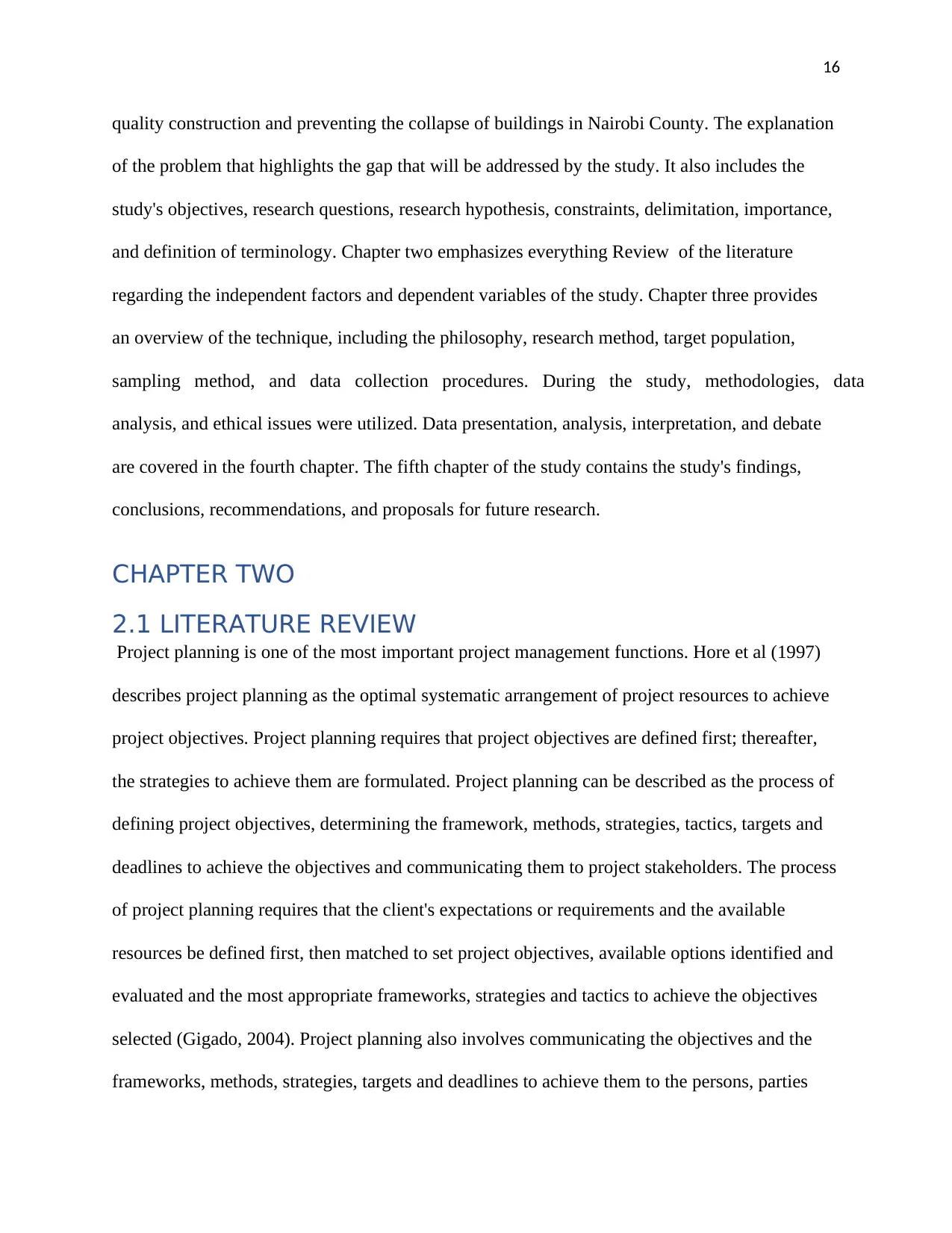
16
quality construction and preventing the collapse of buildings in Nairobi County. The explanation
of the problem that highlights the gap that will be addressed by the study. It also includes the
study's objectives, research questions, research hypothesis, constraints, delimitation, importance,
and definition of terminology. Chapter two emphasizes everything Review of the literature
regarding the independent factors and dependent variables of the study. Chapter three provides
an overview of the technique, including the philosophy, research method, target population,
sampling method, and data collection procedures. During the study, methodologies, data
analysis, and ethical issues were utilized. Data presentation, analysis, interpretation, and debate
are covered in the fourth chapter. The fifth chapter of the study contains the study's findings,
conclusions, recommendations, and proposals for future research.
CHAPTER TWO
2.1 LITERATURE REVIEW
Project planning is one of the most important project management functions. Hore et al (1997)
describes project planning as the optimal systematic arrangement of project resources to achieve
project objectives. Project planning requires that project objectives are defined first; thereafter,
the strategies to achieve them are formulated. Project planning can be described as the process of
defining project objectives, determining the framework, methods, strategies, tactics, targets and
deadlines to achieve the objectives and communicating them to project stakeholders. The process
of project planning requires that the client's expectations or requirements and the available
resources be defined first, then matched to set project objectives, available options identified and
evaluated and the most appropriate frameworks, strategies and tactics to achieve the objectives
selected (Gigado, 2004). Project planning also involves communicating the objectives and the
frameworks, methods, strategies, targets and deadlines to achieve them to the persons, parties
quality construction and preventing the collapse of buildings in Nairobi County. The explanation
of the problem that highlights the gap that will be addressed by the study. It also includes the
study's objectives, research questions, research hypothesis, constraints, delimitation, importance,
and definition of terminology. Chapter two emphasizes everything Review of the literature
regarding the independent factors and dependent variables of the study. Chapter three provides
an overview of the technique, including the philosophy, research method, target population,
sampling method, and data collection procedures. During the study, methodologies, data
analysis, and ethical issues were utilized. Data presentation, analysis, interpretation, and debate
are covered in the fourth chapter. The fifth chapter of the study contains the study's findings,
conclusions, recommendations, and proposals for future research.
CHAPTER TWO
2.1 LITERATURE REVIEW
Project planning is one of the most important project management functions. Hore et al (1997)
describes project planning as the optimal systematic arrangement of project resources to achieve
project objectives. Project planning requires that project objectives are defined first; thereafter,
the strategies to achieve them are formulated. Project planning can be described as the process of
defining project objectives, determining the framework, methods, strategies, tactics, targets and
deadlines to achieve the objectives and communicating them to project stakeholders. The process
of project planning requires that the client's expectations or requirements and the available
resources be defined first, then matched to set project objectives, available options identified and
evaluated and the most appropriate frameworks, strategies and tactics to achieve the objectives
selected (Gigado, 2004). Project planning also involves communicating the objectives and the
frameworks, methods, strategies, targets and deadlines to achieve them to the persons, parties
Paraphrase This Document
Need a fresh take? Get an instant paraphrase of this document with our AI Paraphraser

17
and organizations concerned with their implementation, monitoring and control. The process
involves preparing numerous project plans, each representing defined strategies to achieve
defined project objective. Faniran et al (1998) describes project planning as the process of
determining the appropriate strategies for the achievement of predefined project objectives. The
above studies indicate that a project plan is a document that specifies one or more project
objectives and how to achieve them. Several plans are required for the effective delivery of a
project. While a plan may comprise two or more objectives, two or more plans may target the
same objective.
Theories of project management linked to this study include:
Construction Management Theory
The Construction Management Theory (CMT) proposed by Bennett & Radosavljevic (2012)
provides a “rough theory” on the basis of a “tool kit of relationships and concepts” which will
enhance the quality of and the efficiency of “construction products” (Valence, 2013). The
difference between the traditional approach of CM, where developers delivered the projects, and
the new approach where companies produce a product is a crucial aspect in the thinking behind
this theory of construction management.
Bennett and Radosavljevic (2012) acknowledge that due to the complexity of construction
projects, it is essential to understand the concepts and factors inherent in construction projects.
The concepts under this theory are learning and performance, interactions and relationships,
products and processes, and organizations. Valence (2013) note that the factors that underlie
these concepts include how well established the relationships are (termed internal) or not (termed
boundary relationships), feedback loops, and communication.
and organizations concerned with their implementation, monitoring and control. The process
involves preparing numerous project plans, each representing defined strategies to achieve
defined project objective. Faniran et al (1998) describes project planning as the process of
determining the appropriate strategies for the achievement of predefined project objectives. The
above studies indicate that a project plan is a document that specifies one or more project
objectives and how to achieve them. Several plans are required for the effective delivery of a
project. While a plan may comprise two or more objectives, two or more plans may target the
same objective.
Theories of project management linked to this study include:
Construction Management Theory
The Construction Management Theory (CMT) proposed by Bennett & Radosavljevic (2012)
provides a “rough theory” on the basis of a “tool kit of relationships and concepts” which will
enhance the quality of and the efficiency of “construction products” (Valence, 2013). The
difference between the traditional approach of CM, where developers delivered the projects, and
the new approach where companies produce a product is a crucial aspect in the thinking behind
this theory of construction management.
Bennett and Radosavljevic (2012) acknowledge that due to the complexity of construction
projects, it is essential to understand the concepts and factors inherent in construction projects.
The concepts under this theory are learning and performance, interactions and relationships,
products and processes, and organizations. Valence (2013) note that the factors that underlie
these concepts include how well established the relationships are (termed internal) or not (termed
boundary relationships), feedback loops, and communication.
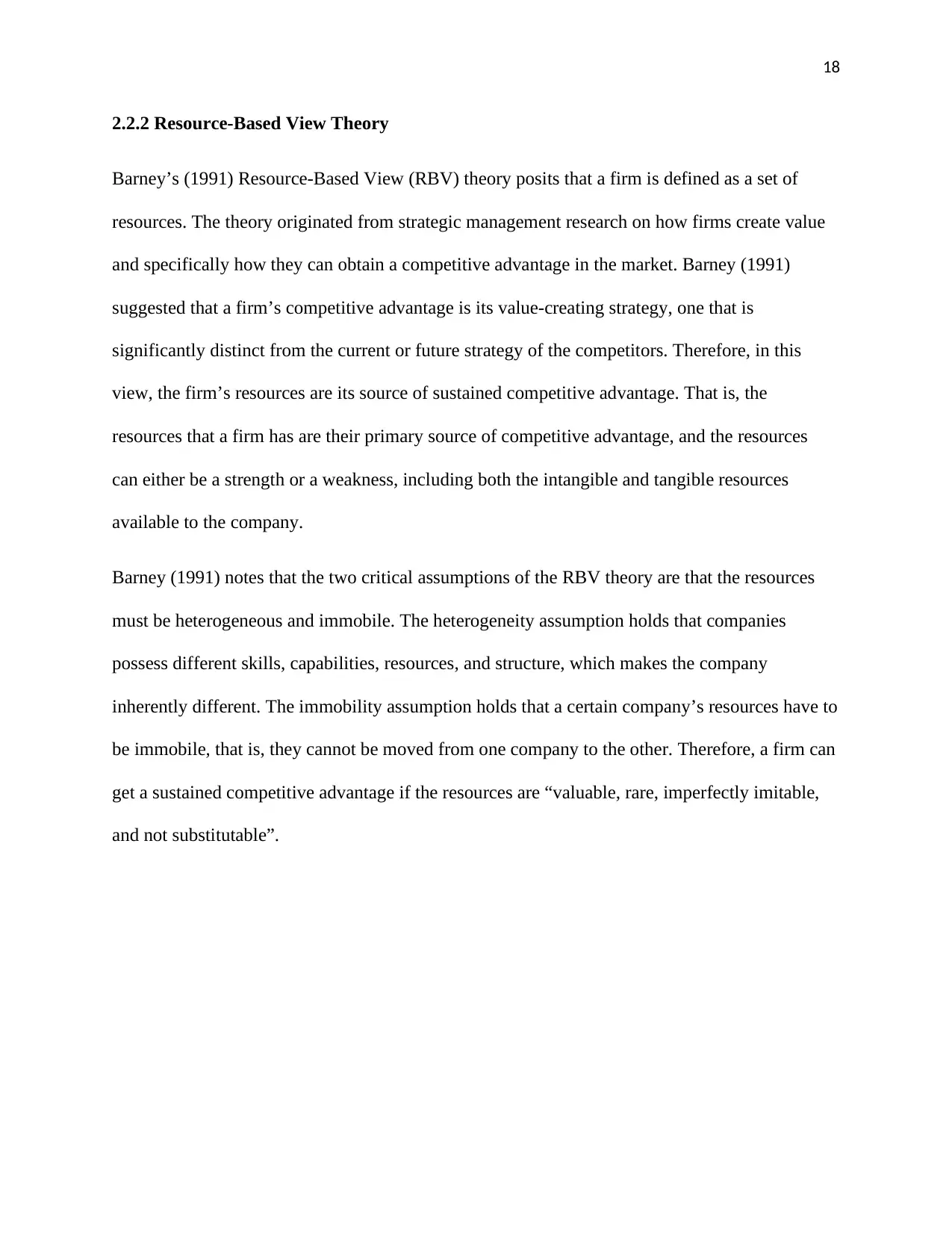
18
2.2.2 Resource-Based View Theory
Barney’s (1991) Resource-Based View (RBV) theory posits that a firm is defined as a set of
resources. The theory originated from strategic management research on how firms create value
and specifically how they can obtain a competitive advantage in the market. Barney (1991)
suggested that a firm’s competitive advantage is its value-creating strategy, one that is
significantly distinct from the current or future strategy of the competitors. Therefore, in this
view, the firm’s resources are its source of sustained competitive advantage. That is, the
resources that a firm has are their primary source of competitive advantage, and the resources
can either be a strength or a weakness, including both the intangible and tangible resources
available to the company.
Barney (1991) notes that the two critical assumptions of the RBV theory are that the resources
must be heterogeneous and immobile. The heterogeneity assumption holds that companies
possess different skills, capabilities, resources, and structure, which makes the company
inherently different. The immobility assumption holds that a certain company’s resources have to
be immobile, that is, they cannot be moved from one company to the other. Therefore, a firm can
get a sustained competitive advantage if the resources are “valuable, rare, imperfectly imitable,
and not substitutable”.
2.2.2 Resource-Based View Theory
Barney’s (1991) Resource-Based View (RBV) theory posits that a firm is defined as a set of
resources. The theory originated from strategic management research on how firms create value
and specifically how they can obtain a competitive advantage in the market. Barney (1991)
suggested that a firm’s competitive advantage is its value-creating strategy, one that is
significantly distinct from the current or future strategy of the competitors. Therefore, in this
view, the firm’s resources are its source of sustained competitive advantage. That is, the
resources that a firm has are their primary source of competitive advantage, and the resources
can either be a strength or a weakness, including both the intangible and tangible resources
available to the company.
Barney (1991) notes that the two critical assumptions of the RBV theory are that the resources
must be heterogeneous and immobile. The heterogeneity assumption holds that companies
possess different skills, capabilities, resources, and structure, which makes the company
inherently different. The immobility assumption holds that a certain company’s resources have to
be immobile, that is, they cannot be moved from one company to the other. Therefore, a firm can
get a sustained competitive advantage if the resources are “valuable, rare, imperfectly imitable,
and not substitutable”.
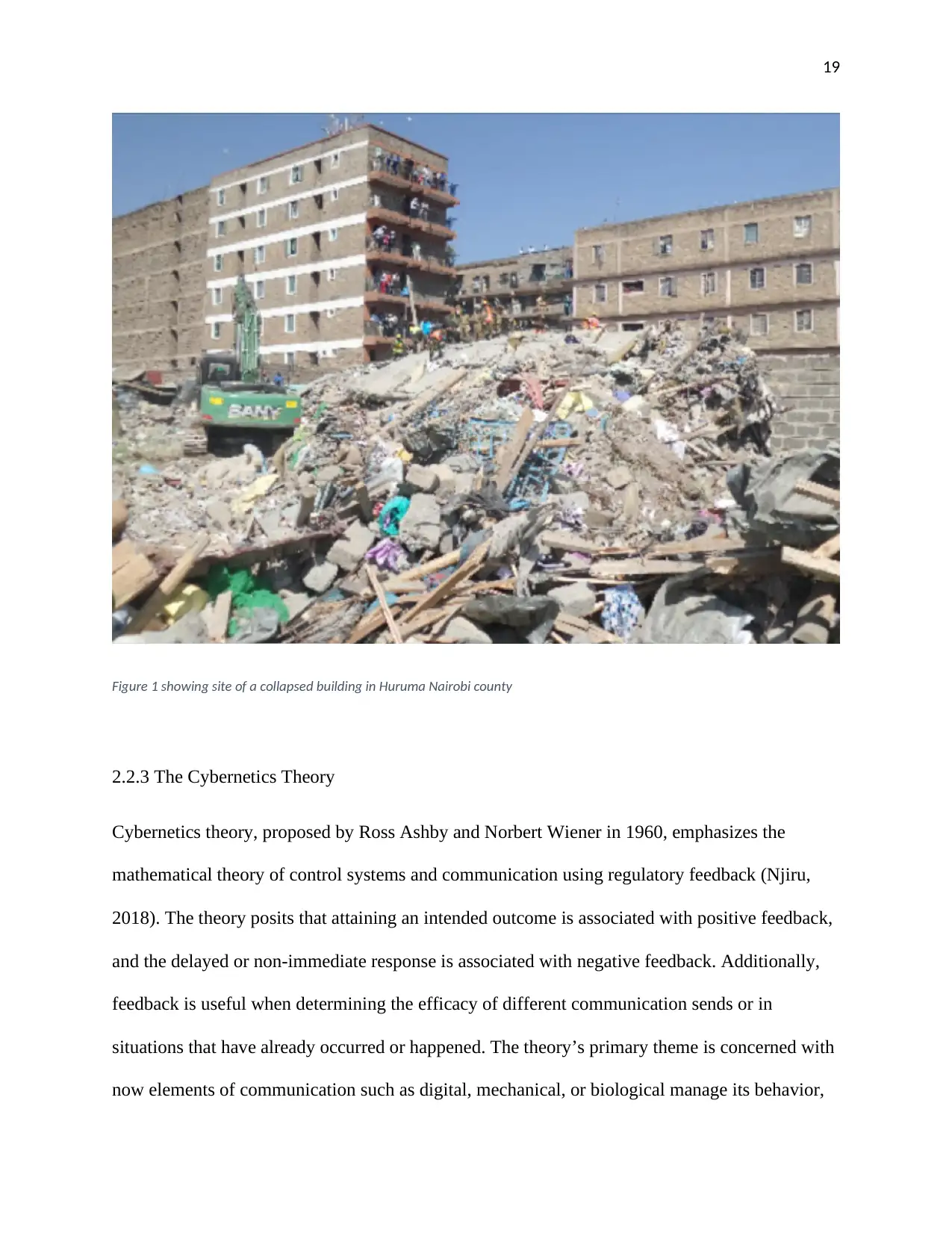
19
Figure 1 showing site of a collapsed building in Huruma Nairobi county
2.2.3 The Cybernetics Theory
Cybernetics theory, proposed by Ross Ashby and Norbert Wiener in 1960, emphasizes the
mathematical theory of control systems and communication using regulatory feedback (Njiru,
2018). The theory posits that attaining an intended outcome is associated with positive feedback,
and the delayed or non-immediate response is associated with negative feedback. Additionally,
feedback is useful when determining the efficacy of different communication sends or in
situations that have already occurred or happened. The theory’s primary theme is concerned with
now elements of communication such as digital, mechanical, or biological manage its behavior,
Figure 1 showing site of a collapsed building in Huruma Nairobi county
2.2.3 The Cybernetics Theory
Cybernetics theory, proposed by Ross Ashby and Norbert Wiener in 1960, emphasizes the
mathematical theory of control systems and communication using regulatory feedback (Njiru,
2018). The theory posits that attaining an intended outcome is associated with positive feedback,
and the delayed or non-immediate response is associated with negative feedback. Additionally,
feedback is useful when determining the efficacy of different communication sends or in
situations that have already occurred or happened. The theory’s primary theme is concerned with
now elements of communication such as digital, mechanical, or biological manage its behavior,
Secure Best Marks with AI Grader
Need help grading? Try our AI Grader for instant feedback on your assignments.
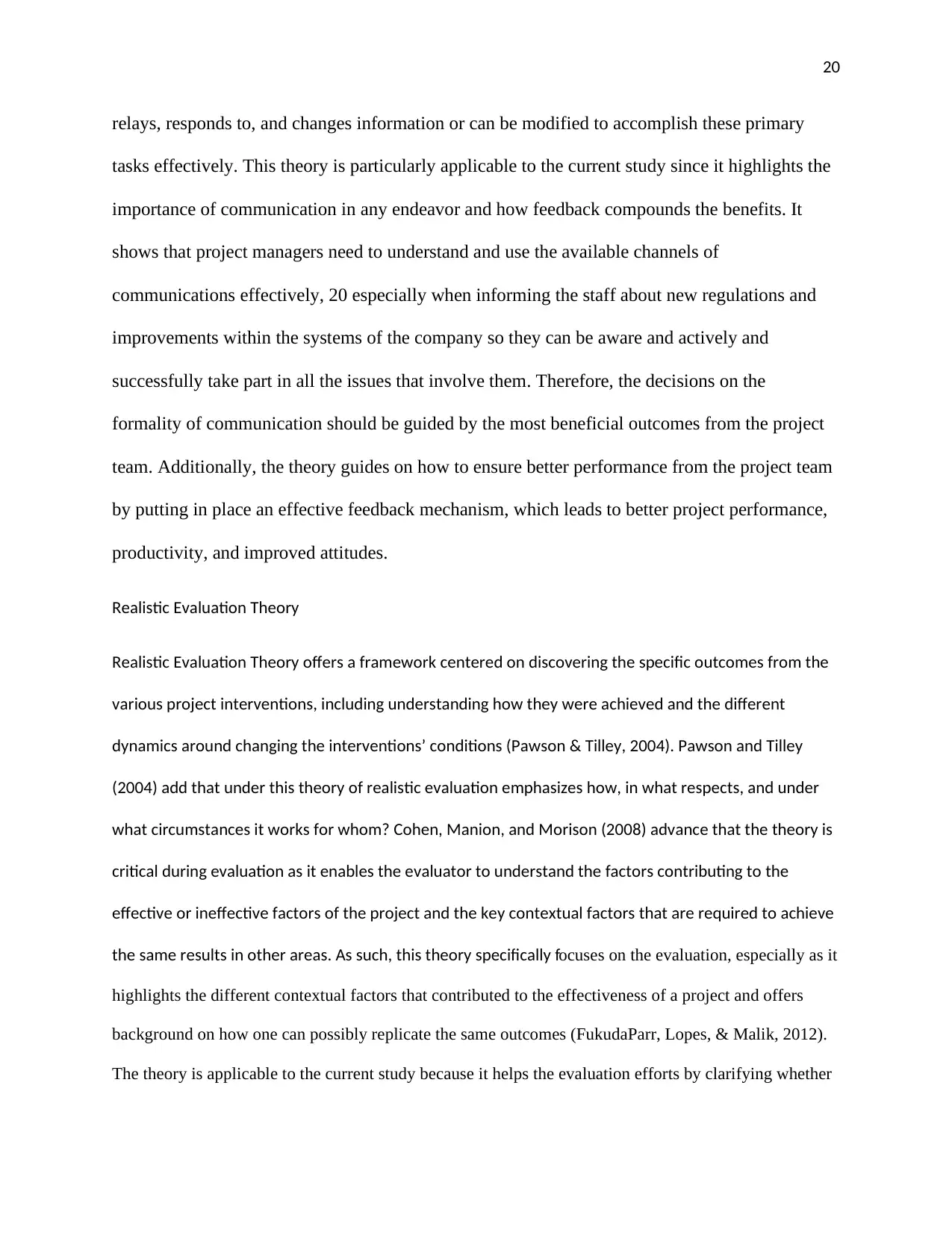
20
relays, responds to, and changes information or can be modified to accomplish these primary
tasks effectively. This theory is particularly applicable to the current study since it highlights the
importance of communication in any endeavor and how feedback compounds the benefits. It
shows that project managers need to understand and use the available channels of
communications effectively, 20 especially when informing the staff about new regulations and
improvements within the systems of the company so they can be aware and actively and
successfully take part in all the issues that involve them. Therefore, the decisions on the
formality of communication should be guided by the most beneficial outcomes from the project
team. Additionally, the theory guides on how to ensure better performance from the project team
by putting in place an effective feedback mechanism, which leads to better project performance,
productivity, and improved attitudes.
Realistic Evaluation Theory
Realistic Evaluation Theory offers a framework centered on discovering the specific outcomes from the
various project interventions, including understanding how they were achieved and the different
dynamics around changing the interventions’ conditions (Pawson & Tilley, 2004). Pawson and Tilley
(2004) add that under this theory of realistic evaluation emphasizes how, in what respects, and under
what circumstances it works for whom? Cohen, Manion, and Morison (2008) advance that the theory is
critical during evaluation as it enables the evaluator to understand the factors contributing to the
effective or ineffective factors of the project and the key contextual factors that are required to achieve
the same results in other areas. As such, this theory specifically focuses on the evaluation, especially as it
highlights the different contextual factors that contributed to the effectiveness of a project and offers
background on how one can possibly replicate the same outcomes (FukudaParr, Lopes, & Malik, 2012).
The theory is applicable to the current study because it helps the evaluation efforts by clarifying whether
relays, responds to, and changes information or can be modified to accomplish these primary
tasks effectively. This theory is particularly applicable to the current study since it highlights the
importance of communication in any endeavor and how feedback compounds the benefits. It
shows that project managers need to understand and use the available channels of
communications effectively, 20 especially when informing the staff about new regulations and
improvements within the systems of the company so they can be aware and actively and
successfully take part in all the issues that involve them. Therefore, the decisions on the
formality of communication should be guided by the most beneficial outcomes from the project
team. Additionally, the theory guides on how to ensure better performance from the project team
by putting in place an effective feedback mechanism, which leads to better project performance,
productivity, and improved attitudes.
Realistic Evaluation Theory
Realistic Evaluation Theory offers a framework centered on discovering the specific outcomes from the
various project interventions, including understanding how they were achieved and the different
dynamics around changing the interventions’ conditions (Pawson & Tilley, 2004). Pawson and Tilley
(2004) add that under this theory of realistic evaluation emphasizes how, in what respects, and under
what circumstances it works for whom? Cohen, Manion, and Morison (2008) advance that the theory is
critical during evaluation as it enables the evaluator to understand the factors contributing to the
effective or ineffective factors of the project and the key contextual factors that are required to achieve
the same results in other areas. As such, this theory specifically focuses on the evaluation, especially as it
highlights the different contextual factors that contributed to the effectiveness of a project and offers
background on how one can possibly replicate the same outcomes (FukudaParr, Lopes, & Malik, 2012).
The theory is applicable to the current study because it helps the evaluation efforts by clarifying whether
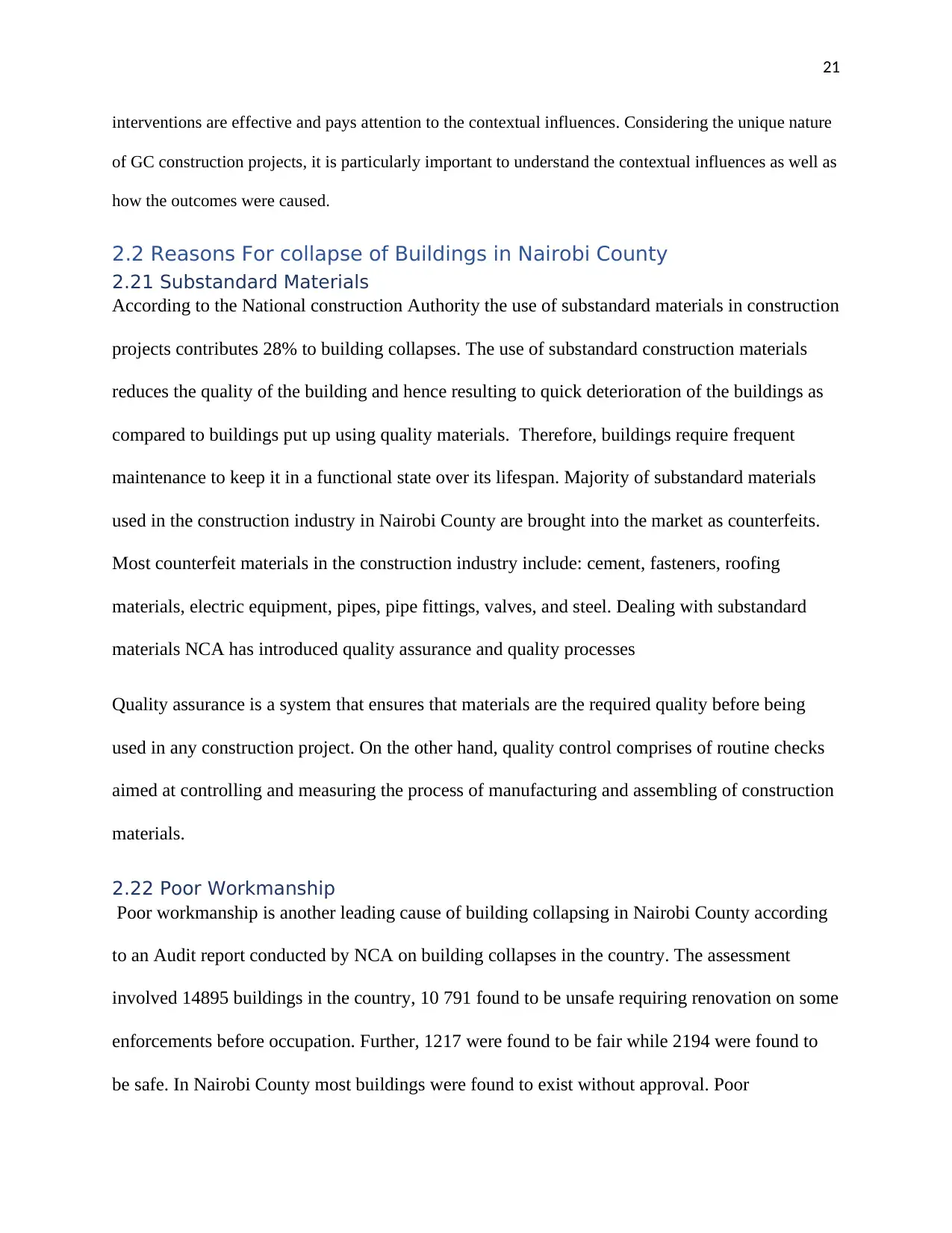
21
interventions are effective and pays attention to the contextual influences. Considering the unique nature
of GC construction projects, it is particularly important to understand the contextual influences as well as
how the outcomes were caused.
2.2 Reasons For collapse of Buildings in Nairobi County
2.21 Substandard Materials
According to the National construction Authority the use of substandard materials in construction
projects contributes 28% to building collapses. The use of substandard construction materials
reduces the quality of the building and hence resulting to quick deterioration of the buildings as
compared to buildings put up using quality materials. Therefore, buildings require frequent
maintenance to keep it in a functional state over its lifespan. Majority of substandard materials
used in the construction industry in Nairobi County are brought into the market as counterfeits.
Most counterfeit materials in the construction industry include: cement, fasteners, roofing
materials, electric equipment, pipes, pipe fittings, valves, and steel. Dealing with substandard
materials NCA has introduced quality assurance and quality processes
Quality assurance is a system that ensures that materials are the required quality before being
used in any construction project. On the other hand, quality control comprises of routine checks
aimed at controlling and measuring the process of manufacturing and assembling of construction
materials.
2.22 Poor Workmanship
Poor workmanship is another leading cause of building collapsing in Nairobi County according
to an Audit report conducted by NCA on building collapses in the country. The assessment
involved 14895 buildings in the country, 10 791 found to be unsafe requiring renovation on some
enforcements before occupation. Further, 1217 were found to be fair while 2194 were found to
be safe. In Nairobi County most buildings were found to exist without approval. Poor
interventions are effective and pays attention to the contextual influences. Considering the unique nature
of GC construction projects, it is particularly important to understand the contextual influences as well as
how the outcomes were caused.
2.2 Reasons For collapse of Buildings in Nairobi County
2.21 Substandard Materials
According to the National construction Authority the use of substandard materials in construction
projects contributes 28% to building collapses. The use of substandard construction materials
reduces the quality of the building and hence resulting to quick deterioration of the buildings as
compared to buildings put up using quality materials. Therefore, buildings require frequent
maintenance to keep it in a functional state over its lifespan. Majority of substandard materials
used in the construction industry in Nairobi County are brought into the market as counterfeits.
Most counterfeit materials in the construction industry include: cement, fasteners, roofing
materials, electric equipment, pipes, pipe fittings, valves, and steel. Dealing with substandard
materials NCA has introduced quality assurance and quality processes
Quality assurance is a system that ensures that materials are the required quality before being
used in any construction project. On the other hand, quality control comprises of routine checks
aimed at controlling and measuring the process of manufacturing and assembling of construction
materials.
2.22 Poor Workmanship
Poor workmanship is another leading cause of building collapsing in Nairobi County according
to an Audit report conducted by NCA on building collapses in the country. The assessment
involved 14895 buildings in the country, 10 791 found to be unsafe requiring renovation on some
enforcements before occupation. Further, 1217 were found to be fair while 2194 were found to
be safe. In Nairobi County most buildings were found to exist without approval. Poor

22
workmanship contributes 35% of the building collapses cases according NCA hence making it
the major and leading cause of building collapses in the country and in Nairobi County. This
problem can be solved by ensuring quality workmanship is enforced in construction projects by
engaging skilled and accredited construction workers and supervisors.
2.23 Quack Contractors
Quack contractors are organizations or individuals that falsely represent themselves as qualified
and proceed to execute building construction works as per the terms of an agreement or the given
contracts. Quack contractors in the Kenyan construction industry are on the rise because clients
are always on the look out to cut costs. Thus, the clients instead of engaging qualified contractors
they settle for quacks in order to spent less. Quack contractors contribute 9% of the building
collapses in Nairobi County.
The best method for dealing with quack contractors involves ensuring that all contractors are
registered with NCA for any construction work and imposition of severe fines can go a long way
in eradication of quack contractors.
2.24 Incompetence of construction workers
According to NCA the Kenyan construction industry has more than 511576 workers.
Additionally, the industry relies majorly on unskilled labor force who account for 42% of the
labor force. Skilled labor force account for 35% while semi-skilled labor force account for 25%
people employed in the industry. NCA posits that construction workers are either professional,
artisans, employed in the construction industry and any associated infrastructure. The
construction workers carry out different tasks in the construction site which include: loading of
heavy equipment, scaffolding, removing debris, loading and offloading of building materials.
workmanship contributes 35% of the building collapses cases according NCA hence making it
the major and leading cause of building collapses in the country and in Nairobi County. This
problem can be solved by ensuring quality workmanship is enforced in construction projects by
engaging skilled and accredited construction workers and supervisors.
2.23 Quack Contractors
Quack contractors are organizations or individuals that falsely represent themselves as qualified
and proceed to execute building construction works as per the terms of an agreement or the given
contracts. Quack contractors in the Kenyan construction industry are on the rise because clients
are always on the look out to cut costs. Thus, the clients instead of engaging qualified contractors
they settle for quacks in order to spent less. Quack contractors contribute 9% of the building
collapses in Nairobi County.
The best method for dealing with quack contractors involves ensuring that all contractors are
registered with NCA for any construction work and imposition of severe fines can go a long way
in eradication of quack contractors.
2.24 Incompetence of construction workers
According to NCA the Kenyan construction industry has more than 511576 workers.
Additionally, the industry relies majorly on unskilled labor force who account for 42% of the
labor force. Skilled labor force account for 35% while semi-skilled labor force account for 25%
people employed in the industry. NCA posits that construction workers are either professional,
artisans, employed in the construction industry and any associated infrastructure. The
construction workers carry out different tasks in the construction site which include: loading of
heavy equipment, scaffolding, removing debris, loading and offloading of building materials.
Paraphrase This Document
Need a fresh take? Get an instant paraphrase of this document with our AI Paraphraser
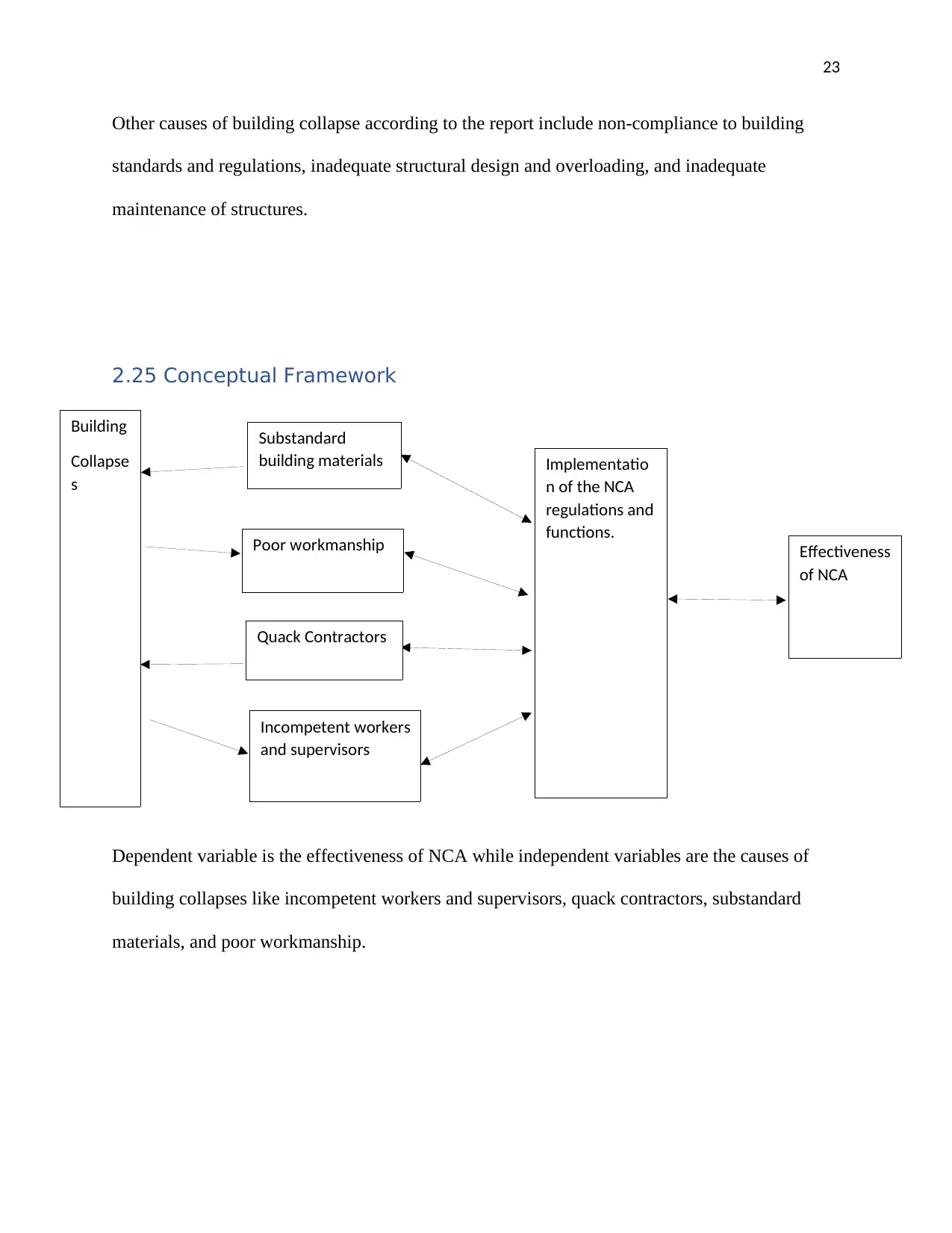
23
Other causes of building collapse according to the report include non-compliance to building
standards and regulations, inadequate structural design and overloading, and inadequate
maintenance of structures.
2.25 Conceptual Framework
Dependent variable is the effectiveness of NCA while independent variables are the causes of
building collapses like incompetent workers and supervisors, quack contractors, substandard
materials, and poor workmanship.
Building
Collapse
s
Substandard
building materials
Poor workmanship
Incompetent workers
and supervisors
Quack Contractors
Implementatio
n of the NCA
regulations and
functions.
Effectiveness
of NCA
Other causes of building collapse according to the report include non-compliance to building
standards and regulations, inadequate structural design and overloading, and inadequate
maintenance of structures.
2.25 Conceptual Framework
Dependent variable is the effectiveness of NCA while independent variables are the causes of
building collapses like incompetent workers and supervisors, quack contractors, substandard
materials, and poor workmanship.
Building
Collapse
s
Substandard
building materials
Poor workmanship
Incompetent workers
and supervisors
Quack Contractors
Implementatio
n of the NCA
regulations and
functions.
Effectiveness
of NCA
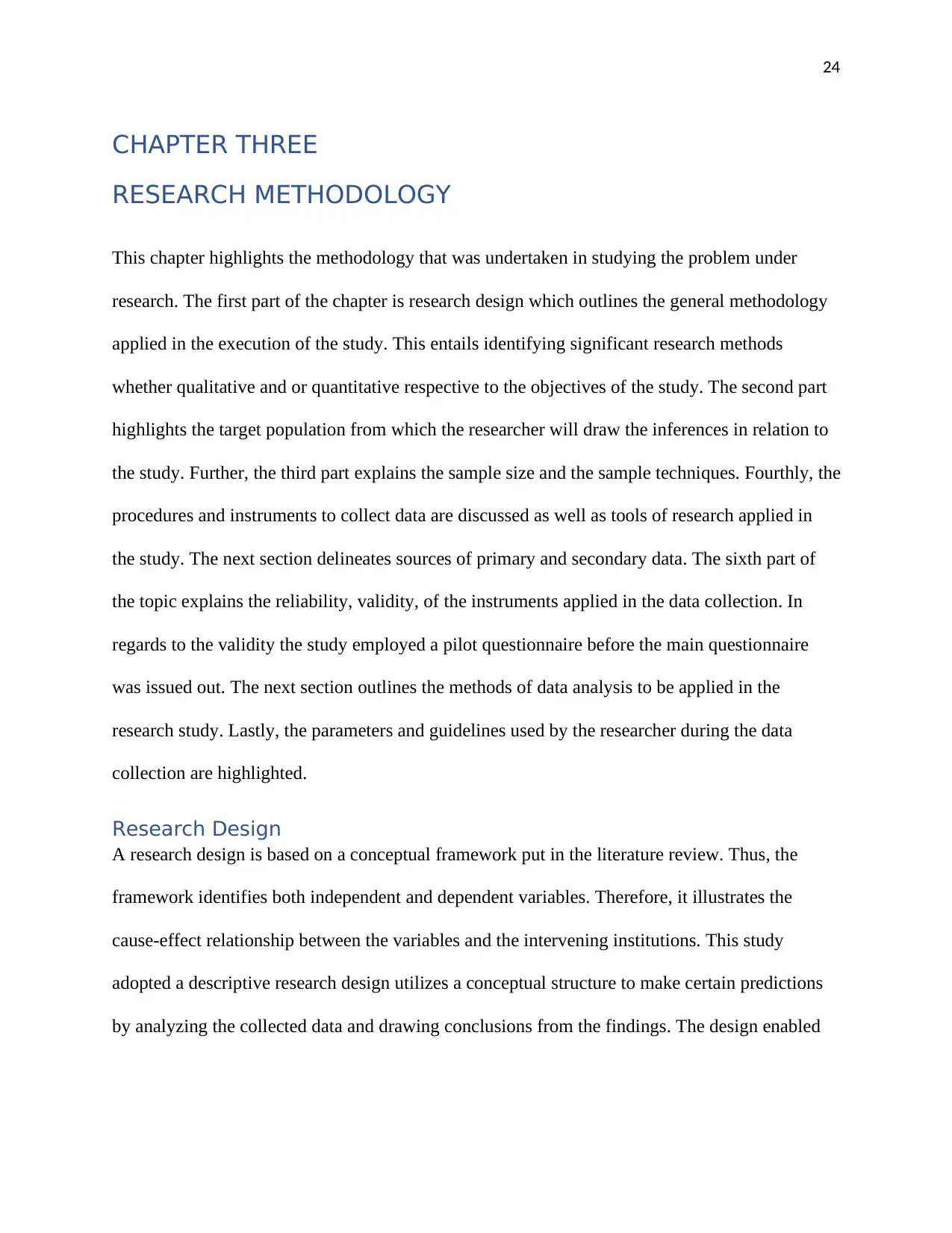
24
CHAPTER THREE
RESEARCH METHODOLOGY
This chapter highlights the methodology that was undertaken in studying the problem under
research. The first part of the chapter is research design which outlines the general methodology
applied in the execution of the study. This entails identifying significant research methods
whether qualitative and or quantitative respective to the objectives of the study. The second part
highlights the target population from which the researcher will draw the inferences in relation to
the study. Further, the third part explains the sample size and the sample techniques. Fourthly, the
procedures and instruments to collect data are discussed as well as tools of research applied in
the study. The next section delineates sources of primary and secondary data. The sixth part of
the topic explains the reliability, validity, of the instruments applied in the data collection. In
regards to the validity the study employed a pilot questionnaire before the main questionnaire
was issued out. The next section outlines the methods of data analysis to be applied in the
research study. Lastly, the parameters and guidelines used by the researcher during the data
collection are highlighted.
Research Design
A research design is based on a conceptual framework put in the literature review. Thus, the
framework identifies both independent and dependent variables. Therefore, it illustrates the
cause-effect relationship between the variables and the intervening institutions. This study
adopted a descriptive research design utilizes a conceptual structure to make certain predictions
by analyzing the collected data and drawing conclusions from the findings. The design enabled
CHAPTER THREE
RESEARCH METHODOLOGY
This chapter highlights the methodology that was undertaken in studying the problem under
research. The first part of the chapter is research design which outlines the general methodology
applied in the execution of the study. This entails identifying significant research methods
whether qualitative and or quantitative respective to the objectives of the study. The second part
highlights the target population from which the researcher will draw the inferences in relation to
the study. Further, the third part explains the sample size and the sample techniques. Fourthly, the
procedures and instruments to collect data are discussed as well as tools of research applied in
the study. The next section delineates sources of primary and secondary data. The sixth part of
the topic explains the reliability, validity, of the instruments applied in the data collection. In
regards to the validity the study employed a pilot questionnaire before the main questionnaire
was issued out. The next section outlines the methods of data analysis to be applied in the
research study. Lastly, the parameters and guidelines used by the researcher during the data
collection are highlighted.
Research Design
A research design is based on a conceptual framework put in the literature review. Thus, the
framework identifies both independent and dependent variables. Therefore, it illustrates the
cause-effect relationship between the variables and the intervening institutions. This study
adopted a descriptive research design utilizes a conceptual structure to make certain predictions
by analyzing the collected data and drawing conclusions from the findings. The design enabled
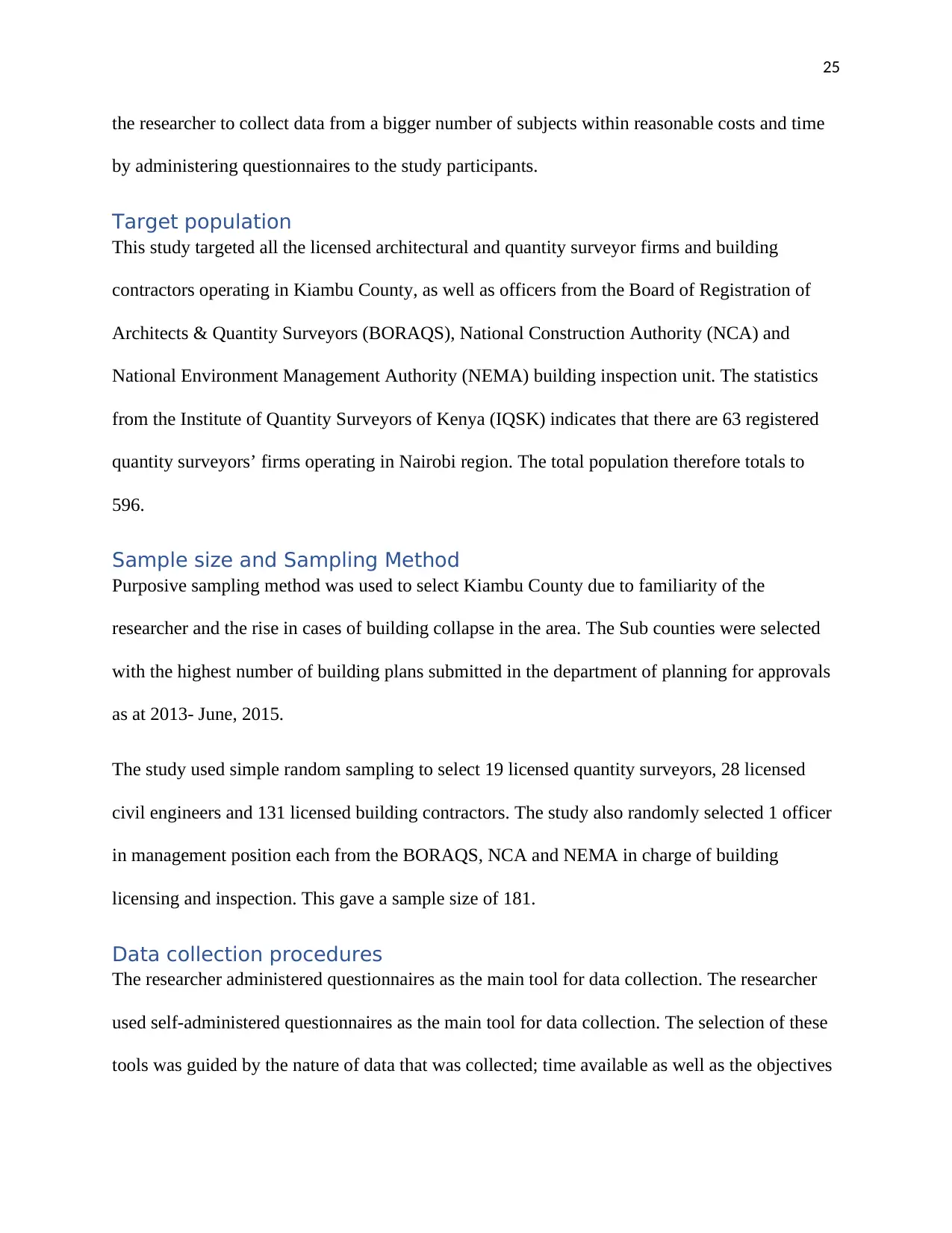
25
the researcher to collect data from a bigger number of subjects within reasonable costs and time
by administering questionnaires to the study participants.
Target population
This study targeted all the licensed architectural and quantity surveyor firms and building
contractors operating in Kiambu County, as well as officers from the Board of Registration of
Architects & Quantity Surveyors (BORAQS), National Construction Authority (NCA) and
National Environment Management Authority (NEMA) building inspection unit. The statistics
from the Institute of Quantity Surveyors of Kenya (IQSK) indicates that there are 63 registered
quantity surveyors’ firms operating in Nairobi region. The total population therefore totals to
596.
Sample size and Sampling Method
Purposive sampling method was used to select Kiambu County due to familiarity of the
researcher and the rise in cases of building collapse in the area. The Sub counties were selected
with the highest number of building plans submitted in the department of planning for approvals
as at 2013- June, 2015.
The study used simple random sampling to select 19 licensed quantity surveyors, 28 licensed
civil engineers and 131 licensed building contractors. The study also randomly selected 1 officer
in management position each from the BORAQS, NCA and NEMA in charge of building
licensing and inspection. This gave a sample size of 181.
Data collection procedures
The researcher administered questionnaires as the main tool for data collection. The researcher
used self-administered questionnaires as the main tool for data collection. The selection of these
tools was guided by the nature of data that was collected; time available as well as the objectives
the researcher to collect data from a bigger number of subjects within reasonable costs and time
by administering questionnaires to the study participants.
Target population
This study targeted all the licensed architectural and quantity surveyor firms and building
contractors operating in Kiambu County, as well as officers from the Board of Registration of
Architects & Quantity Surveyors (BORAQS), National Construction Authority (NCA) and
National Environment Management Authority (NEMA) building inspection unit. The statistics
from the Institute of Quantity Surveyors of Kenya (IQSK) indicates that there are 63 registered
quantity surveyors’ firms operating in Nairobi region. The total population therefore totals to
596.
Sample size and Sampling Method
Purposive sampling method was used to select Kiambu County due to familiarity of the
researcher and the rise in cases of building collapse in the area. The Sub counties were selected
with the highest number of building plans submitted in the department of planning for approvals
as at 2013- June, 2015.
The study used simple random sampling to select 19 licensed quantity surveyors, 28 licensed
civil engineers and 131 licensed building contractors. The study also randomly selected 1 officer
in management position each from the BORAQS, NCA and NEMA in charge of building
licensing and inspection. This gave a sample size of 181.
Data collection procedures
The researcher administered questionnaires as the main tool for data collection. The researcher
used self-administered questionnaires as the main tool for data collection. The selection of these
tools was guided by the nature of data that was collected; time available as well as the objectives
Secure Best Marks with AI Grader
Need help grading? Try our AI Grader for instant feedback on your assignments.
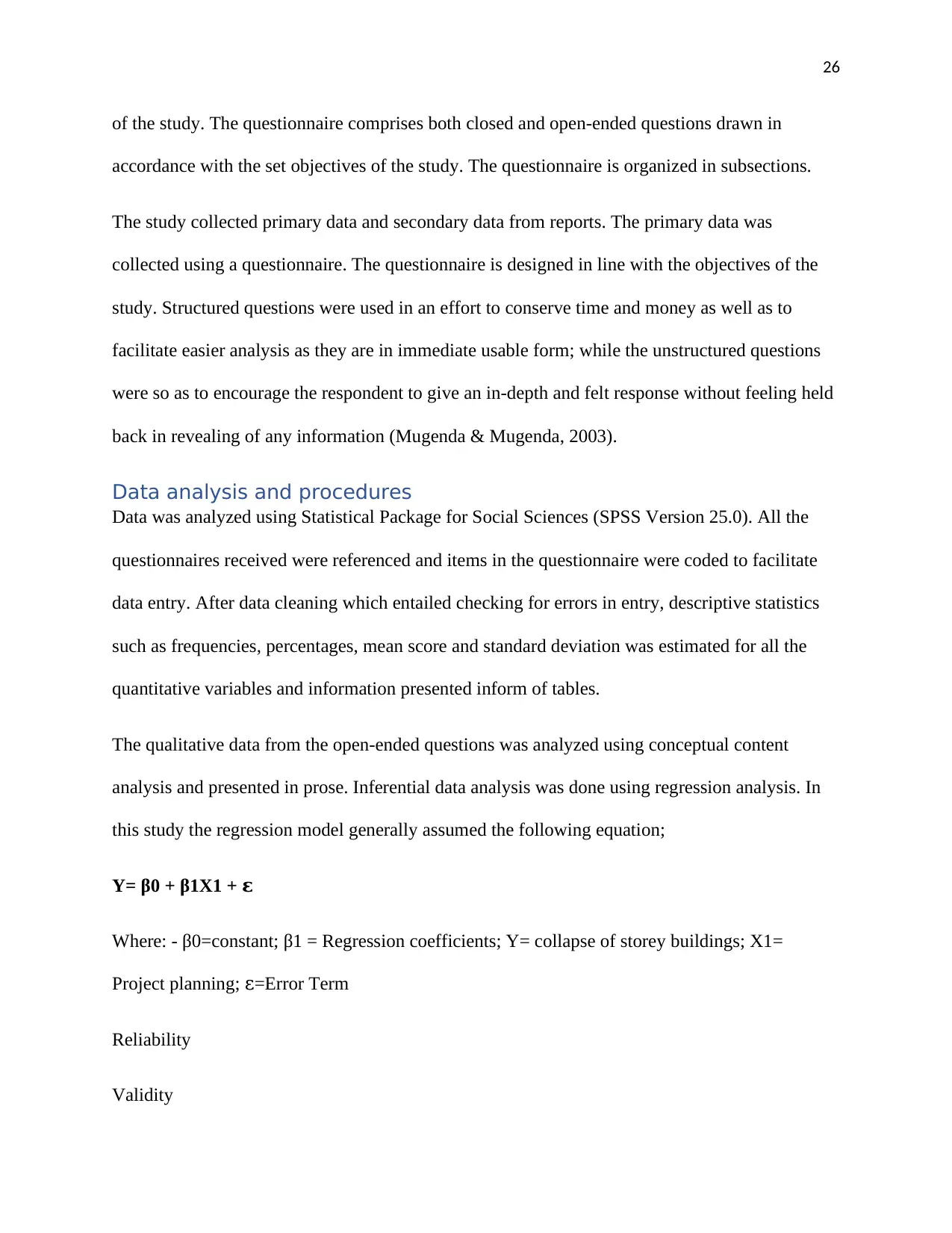
26
of the study. The questionnaire comprises both closed and open-ended questions drawn in
accordance with the set objectives of the study. The questionnaire is organized in subsections.
The study collected primary data and secondary data from reports. The primary data was
collected using a questionnaire. The questionnaire is designed in line with the objectives of the
study. Structured questions were used in an effort to conserve time and money as well as to
facilitate easier analysis as they are in immediate usable form; while the unstructured questions
were so as to encourage the respondent to give an in-depth and felt response without feeling held
back in revealing of any information (Mugenda & Mugenda, 2003).
Data analysis and procedures
Data was analyzed using Statistical Package for Social Sciences (SPSS Version 25.0). All the
questionnaires received were referenced and items in the questionnaire were coded to facilitate
data entry. After data cleaning which entailed checking for errors in entry, descriptive statistics
such as frequencies, percentages, mean score and standard deviation was estimated for all the
quantitative variables and information presented inform of tables.
The qualitative data from the open-ended questions was analyzed using conceptual content
analysis and presented in prose. Inferential data analysis was done using regression analysis. In
this study the regression model generally assumed the following equation;
Y= β0 + β1X1 + ɛ
Where: - β0=constant; β1 = Regression coefficients; Y= collapse of storey buildings; X1=
Project planning; =Error Termɛ
Reliability
Validity
of the study. The questionnaire comprises both closed and open-ended questions drawn in
accordance with the set objectives of the study. The questionnaire is organized in subsections.
The study collected primary data and secondary data from reports. The primary data was
collected using a questionnaire. The questionnaire is designed in line with the objectives of the
study. Structured questions were used in an effort to conserve time and money as well as to
facilitate easier analysis as they are in immediate usable form; while the unstructured questions
were so as to encourage the respondent to give an in-depth and felt response without feeling held
back in revealing of any information (Mugenda & Mugenda, 2003).
Data analysis and procedures
Data was analyzed using Statistical Package for Social Sciences (SPSS Version 25.0). All the
questionnaires received were referenced and items in the questionnaire were coded to facilitate
data entry. After data cleaning which entailed checking for errors in entry, descriptive statistics
such as frequencies, percentages, mean score and standard deviation was estimated for all the
quantitative variables and information presented inform of tables.
The qualitative data from the open-ended questions was analyzed using conceptual content
analysis and presented in prose. Inferential data analysis was done using regression analysis. In
this study the regression model generally assumed the following equation;
Y= β0 + β1X1 + ɛ
Where: - β0=constant; β1 = Regression coefficients; Y= collapse of storey buildings; X1=
Project planning; =Error Termɛ
Reliability
Validity

27
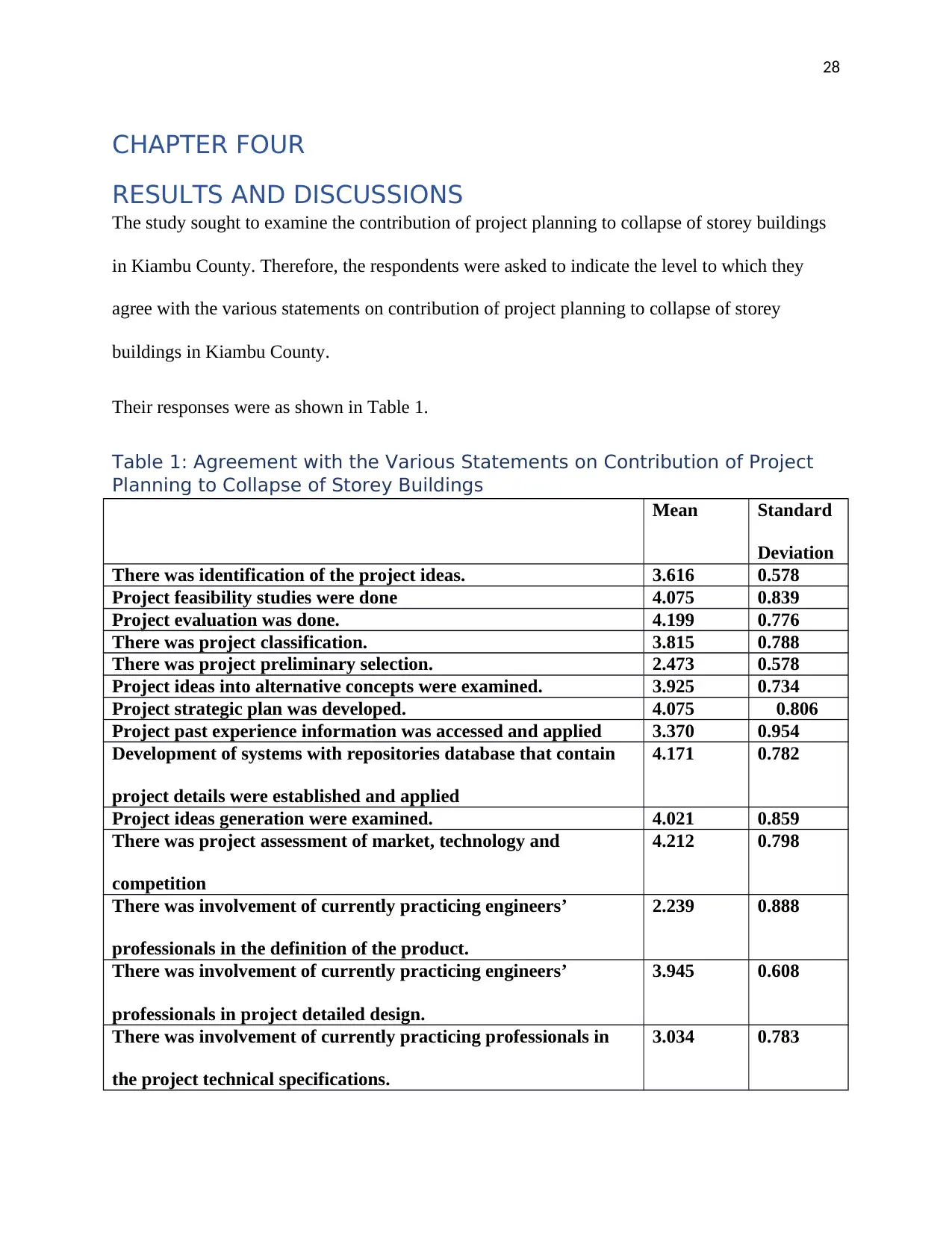
28
CHAPTER FOUR
RESULTS AND DISCUSSIONS
The study sought to examine the contribution of project planning to collapse of storey buildings
in Kiambu County. Therefore, the respondents were asked to indicate the level to which they
agree with the various statements on contribution of project planning to collapse of storey
buildings in Kiambu County.
Their responses were as shown in Table 1.
Table 1: Agreement with the Various Statements on Contribution of Project
Planning to Collapse of Storey Buildings
Mean Standard
Deviation
There was identification of the project ideas. 3.616 0.578
Project feasibility studies were done 4.075 0.839
Project evaluation was done. 4.199 0.776
There was project classification. 3.815 0.788
There was project preliminary selection. 2.473 0.578
Project ideas into alternative concepts were examined. 3.925 0.734
Project strategic plan was developed. 4.075 0.806
Project past experience information was accessed and applied 3.370 0.954
Development of systems with repositories database that contain
project details were established and applied
4.171 0.782
Project ideas generation were examined. 4.021 0.859
There was project assessment of market, technology and
competition
4.212 0.798
There was involvement of currently practicing engineers’
professionals in the definition of the product.
2.239 0.888
There was involvement of currently practicing engineers’
professionals in project detailed design.
3.945 0.608
There was involvement of currently practicing professionals in
the project technical specifications.
3.034 0.783
CHAPTER FOUR
RESULTS AND DISCUSSIONS
The study sought to examine the contribution of project planning to collapse of storey buildings
in Kiambu County. Therefore, the respondents were asked to indicate the level to which they
agree with the various statements on contribution of project planning to collapse of storey
buildings in Kiambu County.
Their responses were as shown in Table 1.
Table 1: Agreement with the Various Statements on Contribution of Project
Planning to Collapse of Storey Buildings
Mean Standard
Deviation
There was identification of the project ideas. 3.616 0.578
Project feasibility studies were done 4.075 0.839
Project evaluation was done. 4.199 0.776
There was project classification. 3.815 0.788
There was project preliminary selection. 2.473 0.578
Project ideas into alternative concepts were examined. 3.925 0.734
Project strategic plan was developed. 4.075 0.806
Project past experience information was accessed and applied 3.370 0.954
Development of systems with repositories database that contain
project details were established and applied
4.171 0.782
Project ideas generation were examined. 4.021 0.859
There was project assessment of market, technology and
competition
4.212 0.798
There was involvement of currently practicing engineers’
professionals in the definition of the product.
2.239 0.888
There was involvement of currently practicing engineers’
professionals in project detailed design.
3.945 0.608
There was involvement of currently practicing professionals in
the project technical specifications.
3.034 0.783
Paraphrase This Document
Need a fresh take? Get an instant paraphrase of this document with our AI Paraphraser

29
From the findings, the respondents agreed that there was project assessment of market,
technology and competition as shown by a mean of 4.212, that project evaluation was done as
illustrated by a mean of 4.199, that development of systems with repositories database that
contain project details were established and applied as shown by a mean of 4.171 and that project
feasibility studies were done as illustrated by a mean of 4.075. This concurs with Gigado (2004)
who argues that project planning also involves communicating the objectives and the
frameworks, methods, strategies, targets and deadlines to achieve them to the persons, parties
and organizations concerned with their implementation, monitoring and control. The process
involves preparing numerous project plans, each representing defined strategies to achieve
defined project objective.
The respondents also agreed that project strategic plan was developed as illustrated by a mean of
4.075, that project ideas generation were examined as illustrated by a mean of 4.021, that there
was involvement of currently practicing engineers’ professionals in project detailed design as
shown by a mean of 3.945 and that project ideas into alternative concepts were examined as
illustrated by a mean of 3.925. Additionally, the respondents agreed that there was project
classification as shown by a mean of 3.815 and that there was identification of the project ideas
as shown by a mean of 3.616. However, the respondents were neutral that project past experience
information was accessed and applied as shown by a mean of 3.370 and that there was
involvement of currently practicing professionals in the project technical specifications as shown
by a mean of 3.034 but disagreed that there was project preliminary selection as shown by a
mean of 2.473 and that there was involvement of currently practicing engineers’ professionals in
the definition of the product as shown by a mean of 2.329. These findings correlate with
Oluwoye and Lenard (1998) who describe project planning as the process of determining the
From the findings, the respondents agreed that there was project assessment of market,
technology and competition as shown by a mean of 4.212, that project evaluation was done as
illustrated by a mean of 4.199, that development of systems with repositories database that
contain project details were established and applied as shown by a mean of 4.171 and that project
feasibility studies were done as illustrated by a mean of 4.075. This concurs with Gigado (2004)
who argues that project planning also involves communicating the objectives and the
frameworks, methods, strategies, targets and deadlines to achieve them to the persons, parties
and organizations concerned with their implementation, monitoring and control. The process
involves preparing numerous project plans, each representing defined strategies to achieve
defined project objective.
The respondents also agreed that project strategic plan was developed as illustrated by a mean of
4.075, that project ideas generation were examined as illustrated by a mean of 4.021, that there
was involvement of currently practicing engineers’ professionals in project detailed design as
shown by a mean of 3.945 and that project ideas into alternative concepts were examined as
illustrated by a mean of 3.925. Additionally, the respondents agreed that there was project
classification as shown by a mean of 3.815 and that there was identification of the project ideas
as shown by a mean of 3.616. However, the respondents were neutral that project past experience
information was accessed and applied as shown by a mean of 3.370 and that there was
involvement of currently practicing professionals in the project technical specifications as shown
by a mean of 3.034 but disagreed that there was project preliminary selection as shown by a
mean of 2.473 and that there was involvement of currently practicing engineers’ professionals in
the definition of the product as shown by a mean of 2.329. These findings correlate with
Oluwoye and Lenard (1998) who describe project planning as the process of determining the
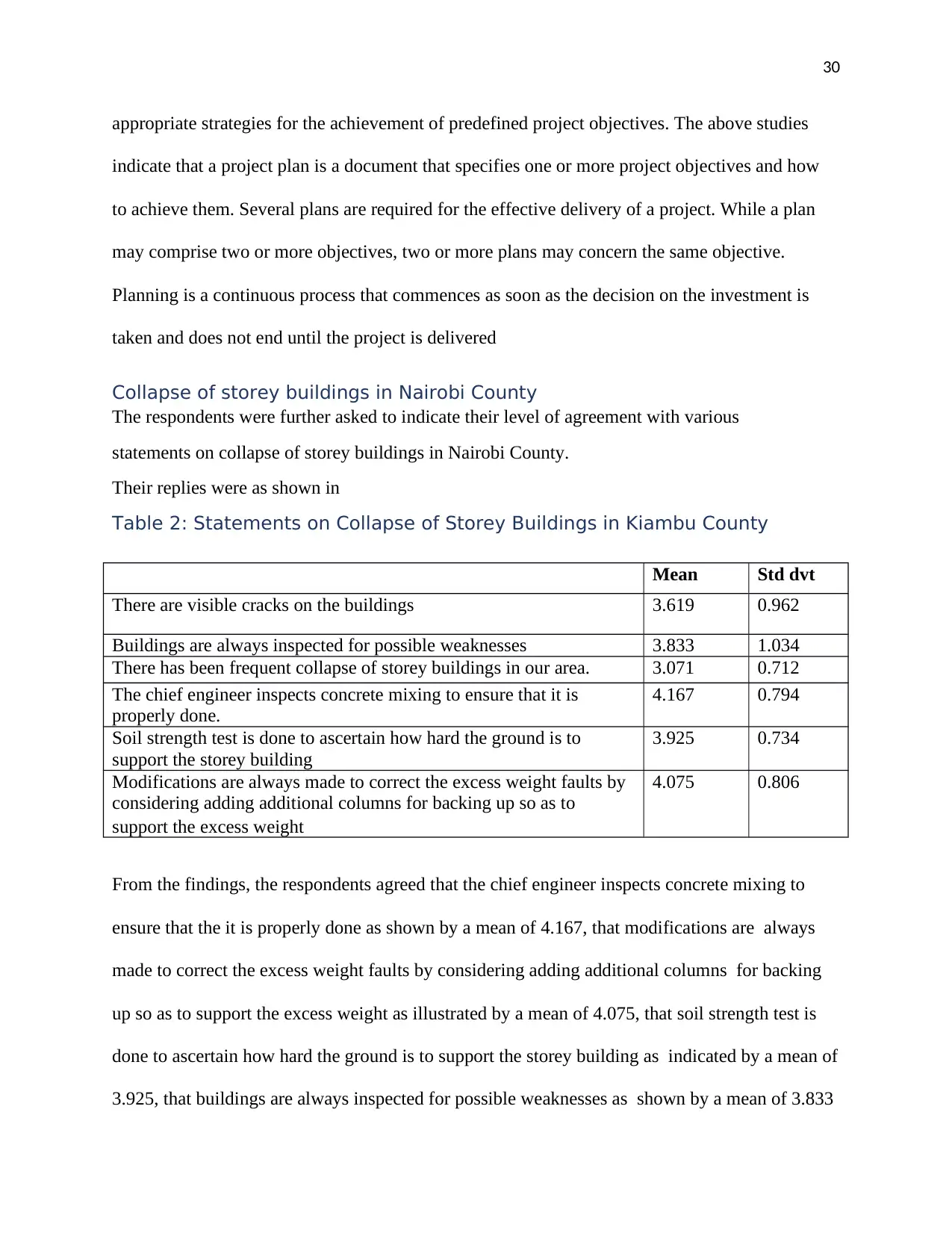
30
appropriate strategies for the achievement of predefined project objectives. The above studies
indicate that a project plan is a document that specifies one or more project objectives and how
to achieve them. Several plans are required for the effective delivery of a project. While a plan
may comprise two or more objectives, two or more plans may concern the same objective.
Planning is a continuous process that commences as soon as the decision on the investment is
taken and does not end until the project is delivered
Collapse of storey buildings in Nairobi County
The respondents were further asked to indicate their level of agreement with various
statements on collapse of storey buildings in Nairobi County.
Their replies were as shown in
Table 2: Statements on Collapse of Storey Buildings in Kiambu County
Mean Std dvt
There are visible cracks on the buildings 3.619 0.962
Buildings are always inspected for possible weaknesses 3.833 1.034
There has been frequent collapse of storey buildings in our area. 3.071 0.712
The chief engineer inspects concrete mixing to ensure that it is
properly done.
4.167 0.794
Soil strength test is done to ascertain how hard the ground is to
support the storey building
3.925 0.734
Modifications are always made to correct the excess weight faults by
considering adding additional columns for backing up so as to
support the excess weight
4.075 0.806
From the findings, the respondents agreed that the chief engineer inspects concrete mixing to
ensure that the it is properly done as shown by a mean of 4.167, that modifications are always
made to correct the excess weight faults by considering adding additional columns for backing
up so as to support the excess weight as illustrated by a mean of 4.075, that soil strength test is
done to ascertain how hard the ground is to support the storey building as indicated by a mean of
3.925, that buildings are always inspected for possible weaknesses as shown by a mean of 3.833
appropriate strategies for the achievement of predefined project objectives. The above studies
indicate that a project plan is a document that specifies one or more project objectives and how
to achieve them. Several plans are required for the effective delivery of a project. While a plan
may comprise two or more objectives, two or more plans may concern the same objective.
Planning is a continuous process that commences as soon as the decision on the investment is
taken and does not end until the project is delivered
Collapse of storey buildings in Nairobi County
The respondents were further asked to indicate their level of agreement with various
statements on collapse of storey buildings in Nairobi County.
Their replies were as shown in
Table 2: Statements on Collapse of Storey Buildings in Kiambu County
Mean Std dvt
There are visible cracks on the buildings 3.619 0.962
Buildings are always inspected for possible weaknesses 3.833 1.034
There has been frequent collapse of storey buildings in our area. 3.071 0.712
The chief engineer inspects concrete mixing to ensure that it is
properly done.
4.167 0.794
Soil strength test is done to ascertain how hard the ground is to
support the storey building
3.925 0.734
Modifications are always made to correct the excess weight faults by
considering adding additional columns for backing up so as to
support the excess weight
4.075 0.806
From the findings, the respondents agreed that the chief engineer inspects concrete mixing to
ensure that the it is properly done as shown by a mean of 4.167, that modifications are always
made to correct the excess weight faults by considering adding additional columns for backing
up so as to support the excess weight as illustrated by a mean of 4.075, that soil strength test is
done to ascertain how hard the ground is to support the storey building as indicated by a mean of
3.925, that buildings are always inspected for possible weaknesses as shown by a mean of 3.833
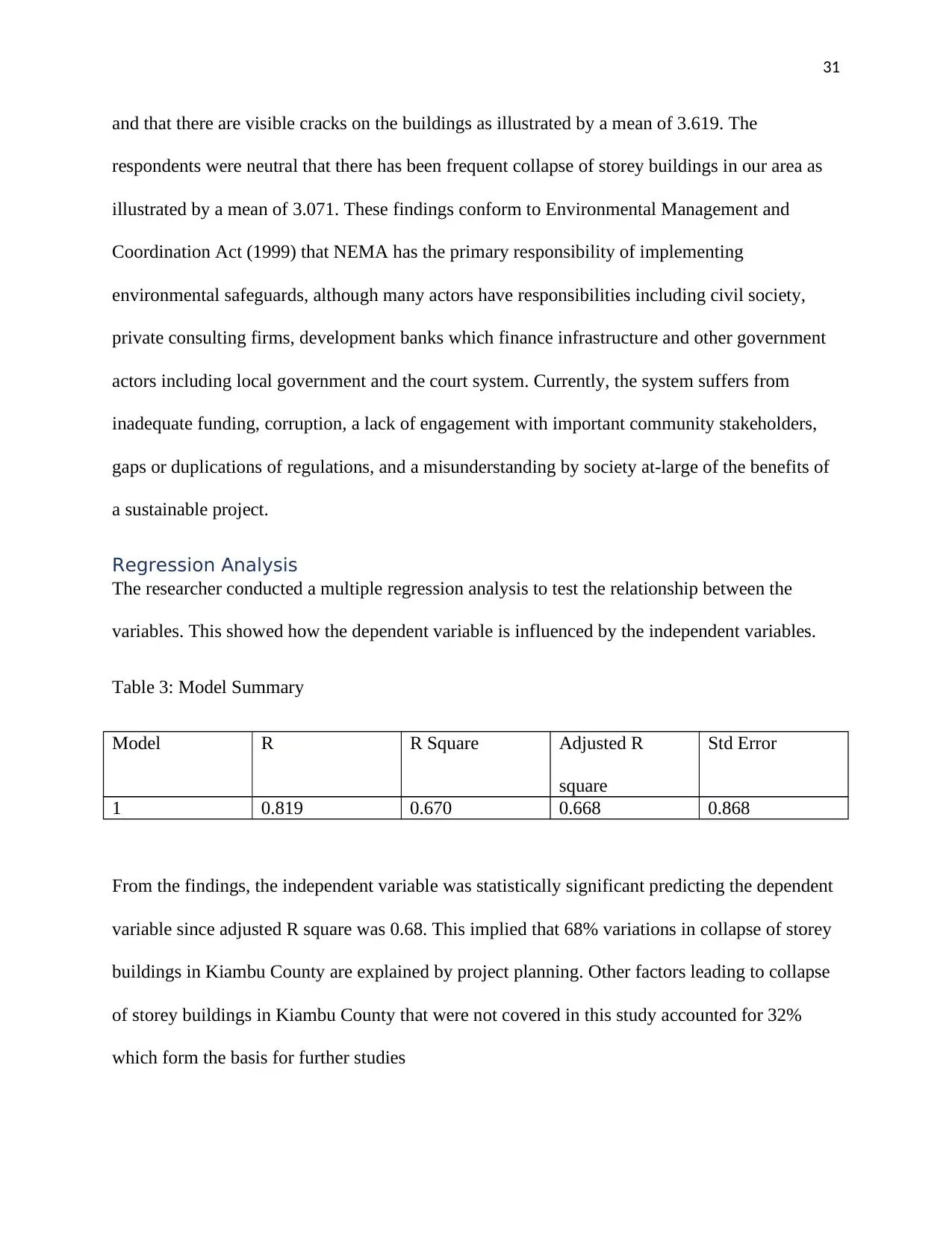
31
and that there are visible cracks on the buildings as illustrated by a mean of 3.619. The
respondents were neutral that there has been frequent collapse of storey buildings in our area as
illustrated by a mean of 3.071. These findings conform to Environmental Management and
Coordination Act (1999) that NEMA has the primary responsibility of implementing
environmental safeguards, although many actors have responsibilities including civil society,
private consulting firms, development banks which finance infrastructure and other government
actors including local government and the court system. Currently, the system suffers from
inadequate funding, corruption, a lack of engagement with important community stakeholders,
gaps or duplications of regulations, and a misunderstanding by society at-large of the benefits of
a sustainable project.
Regression Analysis
The researcher conducted a multiple regression analysis to test the relationship between the
variables. This showed how the dependent variable is influenced by the independent variables.
Table 3: Model Summary
Model R R Square Adjusted R
square
Std Error
1 0.819 0.670 0.668 0.868
From the findings, the independent variable was statistically significant predicting the dependent
variable since adjusted R square was 0.68. This implied that 68% variations in collapse of storey
buildings in Kiambu County are explained by project planning. Other factors leading to collapse
of storey buildings in Kiambu County that were not covered in this study accounted for 32%
which form the basis for further studies
and that there are visible cracks on the buildings as illustrated by a mean of 3.619. The
respondents were neutral that there has been frequent collapse of storey buildings in our area as
illustrated by a mean of 3.071. These findings conform to Environmental Management and
Coordination Act (1999) that NEMA has the primary responsibility of implementing
environmental safeguards, although many actors have responsibilities including civil society,
private consulting firms, development banks which finance infrastructure and other government
actors including local government and the court system. Currently, the system suffers from
inadequate funding, corruption, a lack of engagement with important community stakeholders,
gaps or duplications of regulations, and a misunderstanding by society at-large of the benefits of
a sustainable project.
Regression Analysis
The researcher conducted a multiple regression analysis to test the relationship between the
variables. This showed how the dependent variable is influenced by the independent variables.
Table 3: Model Summary
Model R R Square Adjusted R
square
Std Error
1 0.819 0.670 0.668 0.868
From the findings, the independent variable was statistically significant predicting the dependent
variable since adjusted R square was 0.68. This implied that 68% variations in collapse of storey
buildings in Kiambu County are explained by project planning. Other factors leading to collapse
of storey buildings in Kiambu County that were not covered in this study accounted for 32%
which form the basis for further studies
Secure Best Marks with AI Grader
Need help grading? Try our AI Grader for instant feedback on your assignments.
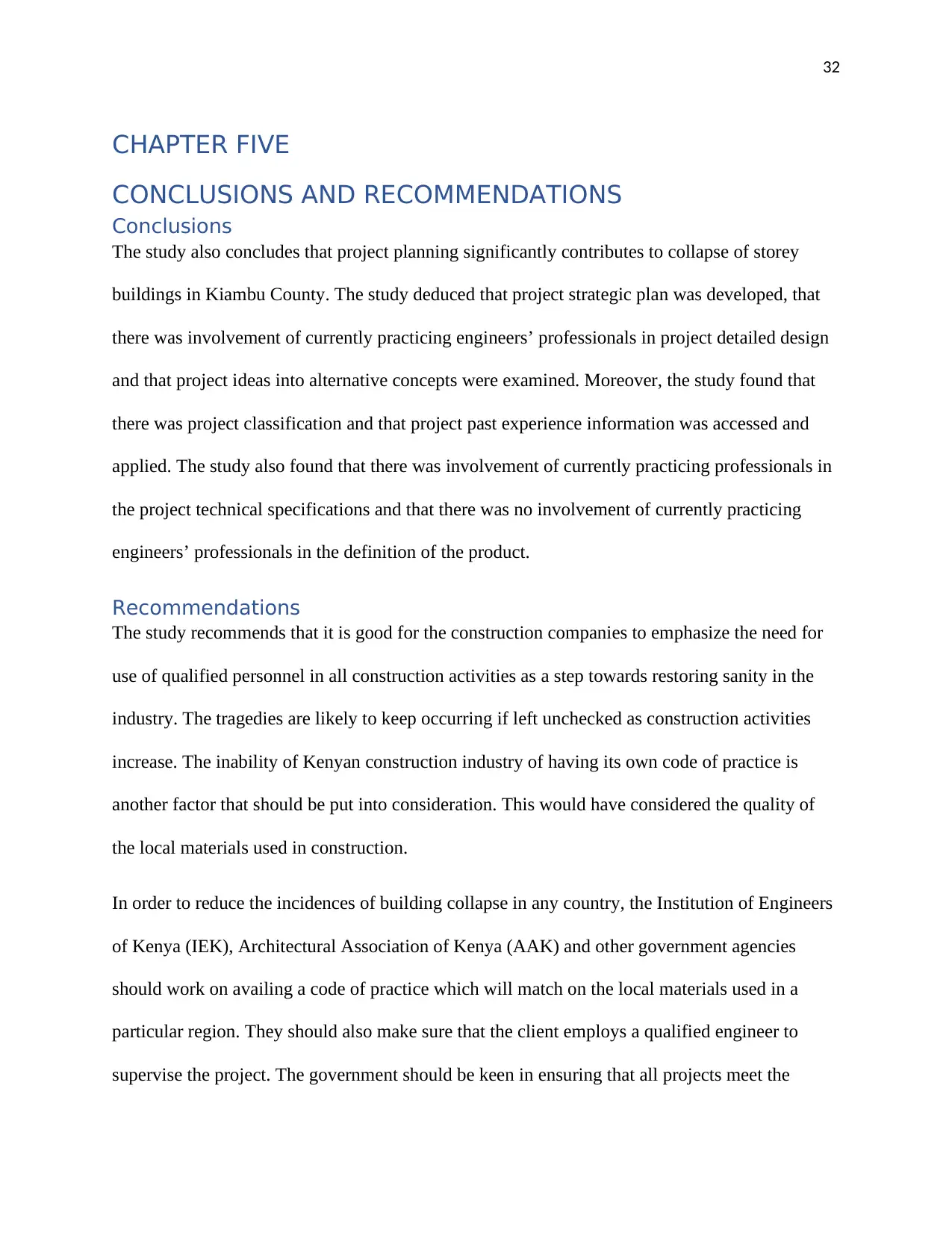
32
CHAPTER FIVE
CONCLUSIONS AND RECOMMENDATIONS
Conclusions
The study also concludes that project planning significantly contributes to collapse of storey
buildings in Kiambu County. The study deduced that project strategic plan was developed, that
there was involvement of currently practicing engineers’ professionals in project detailed design
and that project ideas into alternative concepts were examined. Moreover, the study found that
there was project classification and that project past experience information was accessed and
applied. The study also found that there was involvement of currently practicing professionals in
the project technical specifications and that there was no involvement of currently practicing
engineers’ professionals in the definition of the product.
Recommendations
The study recommends that it is good for the construction companies to emphasize the need for
use of qualified personnel in all construction activities as a step towards restoring sanity in the
industry. The tragedies are likely to keep occurring if left unchecked as construction activities
increase. The inability of Kenyan construction industry of having its own code of practice is
another factor that should be put into consideration. This would have considered the quality of
the local materials used in construction.
In order to reduce the incidences of building collapse in any country, the Institution of Engineers
of Kenya (IEK), Architectural Association of Kenya (AAK) and other government agencies
should work on availing a code of practice which will match on the local materials used in a
particular region. They should also make sure that the client employs a qualified engineer to
supervise the project. The government should be keen in ensuring that all projects meet the
CHAPTER FIVE
CONCLUSIONS AND RECOMMENDATIONS
Conclusions
The study also concludes that project planning significantly contributes to collapse of storey
buildings in Kiambu County. The study deduced that project strategic plan was developed, that
there was involvement of currently practicing engineers’ professionals in project detailed design
and that project ideas into alternative concepts were examined. Moreover, the study found that
there was project classification and that project past experience information was accessed and
applied. The study also found that there was involvement of currently practicing professionals in
the project technical specifications and that there was no involvement of currently practicing
engineers’ professionals in the definition of the product.
Recommendations
The study recommends that it is good for the construction companies to emphasize the need for
use of qualified personnel in all construction activities as a step towards restoring sanity in the
industry. The tragedies are likely to keep occurring if left unchecked as construction activities
increase. The inability of Kenyan construction industry of having its own code of practice is
another factor that should be put into consideration. This would have considered the quality of
the local materials used in construction.
In order to reduce the incidences of building collapse in any country, the Institution of Engineers
of Kenya (IEK), Architectural Association of Kenya (AAK) and other government agencies
should work on availing a code of practice which will match on the local materials used in a
particular region. They should also make sure that the client employs a qualified engineer to
supervise the project. The government should be keen in ensuring that all projects meet the

33
required standards before they are laid on site. Any sort of corruption, poor governance or poor
construction materials that do not meet the required standards of construction will always lead to
loss of lives and properties.
required standards before they are laid on site. Any sort of corruption, poor governance or poor
construction materials that do not meet the required standards of construction will always lead to
loss of lives and properties.

34
References
References
Paraphrase This Document
Need a fresh take? Get an instant paraphrase of this document with our AI Paraphraser

35
1 out of 35
Related Documents
Your All-in-One AI-Powered Toolkit for Academic Success.
+13062052269
info@desklib.com
Available 24*7 on WhatsApp / Email
![[object Object]](/_next/static/media/star-bottom.7253800d.svg)
Unlock your academic potential
© 2024 | Zucol Services PVT LTD | All rights reserved.





